The Diagnostic Deceiver: Radiological Pictorial Review of Tuberculosis
Abstract
:1. Introduction
2. Discussion
2.1. Pulmonary TB
2.1.1. Radiological Patterns of Primary TB
- Lymphadenopathy (Figure 1) is the most common radiological manifestation of primary TB. It is characterized by right paratracheal, hilar, or subcarinal enlarged LNs with or without parenchymal abnormalities. Lymphadenopathy is more likely to occur in children than in adults and may cause pulmonary atelectasis.
2.1.2. Radiological Patterns of Postprimary TB
- Consolidation (Figure 3) is considered to be one of the most common features of postprimary TB, which is usually focal, patchy heterogeneous, or poorly defined. It involves the apical and posterior segments of the upper lobes and the upper segments of the lower lobes [10]. Consolidation with ipsilateral enlarged hilar or paratracheal LNs could strongly suggest TB. CT is better able to detect small and subtle TB consolidations, which are usually peribronchial or subpleural and involve multiple lung segments [13].
- Cavitation (Figure 3 and Figure 4) is a common finding in postprimary TB, and it is characterized as being several centimeters in size with thick irregular walls. Cavities are often seen within consolidation and may persist after treatment predisposing to a bacterial or fungal superinfection or adjacent vascular erosion causing hemoptysis [1,10]. In postprimary TB, both consolidation and cavitation have a predilection for the apical and posterior segments of the upper lobes and the upper segments of the lower lobes [1,14]. This predilection of TB is attributed to the relative over-ventilation, high oxygen tension, and delayed lymphatic clearance in these regions [16]. Thick wall cavities are an important differential diagnosis of a pulmonary abscess, septic emboli, aspergilloma, granulomatosis with polyangitis (Wegener’s granulomatosis), lung malignancy, and others [17].
- Centrilobular nodules (Figure 4 and Figure 5) occur due to the communication of active TB with the bronchial tree resulting in endobronchial spread. It occurs in most cases of active TB. It appears as centrilobular nodules and a tree-in-bud sign on CT images [1,10]. The tree-in-bud pattern is seen on high-resolution CT images as 2–4 mm centrilobular nodules of soft tissue density that are connected to multiple branching linear structures of the similar caliber, arising from a single stalk. It commonly occurs in the endobronchial spread of TB and is highly suggestive of active TB. However, a tree-in-bud is a CT manifestation of the diverse entities of lung diseases, including TB, cytomegalovirus, respiratory syncytial virus, obliterative bronchiolitis, diffuse panbronchiolitis, cystic fibrosis, airway-invasive aspergillosis, allergic bronchopulmonary aspergillosis, and pulmonary metastasis [18].
2.1.3. Radiological Patterns of Both Primary and Postprimary TB
- Miliary TB (Figure 6 and Figure 7) appears as innumerable small (1–3 mm) granulomas with random distribution in the lungs and other organs with a predominance to the lung bases due to the gravity-dependent high blood flow. It occurs due to the hematogenous dissemination of mycobacterium tuberculosis bacilli, especially in immunocompromised patients and children [1,13]. Miliary TB is a significant differential diagnosis of pulmonary metastasis from thyroid cancer or others, even in children [19].
- Pleural effusion (Figure 8) can occur in both primary and postprimary TB; however, it is more common in primary TB, in which it manifests as a unilateral free pleural effusion with no loculations. It is more common in adolescents and adults than in children. It occurs 3–6 months after infection due to a hypersensitivity reaction to mycobacterial antigens and tests negative for bacilli. However, it is usually small and loculated with associated parenchymal lesions in postprimary TB. It originates from the rupture of a cavity into the pleural space, so the cell culture is usually positive for bacilli [13,20].
- Tuberculoma is a well-defined smooth-margin granulomatous nodule or mass up to 5 cm in size, which can be either solitary or multiple and may occur in both primary and postprimary TB. It is more commonly a result from healed primary TB, and the majority remains stable in size and may develop nodular or diffuse calcification or cavitation [13]. Pulmonary tuberculoma can mimic and should be a differential diagnosis of lung cancer [21].
- Tracheobronchial TB can affect the tracheobronchial tree, as well as to the lung, which may cause tracheobronchial stenosis and severe complications. CTs, bronchoscopies, and microbiological investigations are diagnostic tools used to confirm diagnoses and evaluate tracheobronchial stenosis [22].
2.2. Extrapulmonary TB
Central Nervous System (CNS)
- Tuberculous leptomeningitis (Figure 12) is considered to be one of the most common types of neurotuberculosis. It is frequently seen in children and is associated with complications. On an MRI, it appears as diffusely enhancing exudates and leptomeningeal enhancement with predilection where basal cisterns are involved. Magnetization transfer MRI (MT-MRI) is highly valuable for the diagnosis of mild cases of meningitis [25,27]. Tuberculous leptomeningitis has a wide differential diagnosis, including pyogenic leptomeningitis, fungal leptomeningitis, and leptomeningeal carcinomatosis [28]. It can also mimic sarcoidosis [29].
- Tuberculoma (Tuberculous granuloma; Figure 12 and Figure 13) is one of the most common brain parenchymal tuberculous lesions and can be solitary or multiple anywhere within the brain. It is commonly seen at the corticomedullary junction and periventricular region as a result of hematogenous dissemination. MRI features of tuberculoma vary according the stage of maturation (stage 1, non-caseating; stage-2, caseating granuloma; stage 3, caseating granuloma with central liquefaction; and stage 4, calcified granuloma). Radiologically, each stage of brain tuberculoma can mimic a wide variety of differential diagnoses, such as neurocysticercosis, fungal granulomas, pyogenic abscess, metastasis, glioma, lymphoma, and toxoplasmosis [25,27]. Ring-enhancing lesions of the brain may form a diagnostic dilemma [30].
- Miliary tuberculomas (Figure 13) occur due to the haematogenous dissemination of Mycobacterium tuberculosis bacilli, which are usually lung focused and occur especially in immunocompromised patients. They appear as innumerable small (2–3 mm) non-caseating granulomas with random distribution in the brain with a predominance to a gray-white matter junction as a result of hematogenous dissemination [25,26]. Miliary TB usually strongly mimics brain metastasis [31].
- Tuberculous cerebritis (Figure 14) is an infection of a focal area of a brain parenchyma that appears on MRI as an area of swelling with an alteration to the signal intensity of the gyri. The involved gyri appear with a low signal intensity on T1WIs and high signal on T2WIs with patchy enhancement after contrast administration [25,26]. Neuroimaging using a CT and MRI plays a crucial role in early diagnosis and avoids the worst complications of cerebritis. Tuberculous cerebritis is characterized by a small tuberculous granuloma and appears as intense areas of patchy enhancement with edema which mimics infarction those can be differentiated by diffusion-weighted MRI [32].
- Tuberculous abscesses (Figure 15, Figure 16 and Figure 17) are an infrequent pattern of brain TB, which are present in immunocompromised and elderly patients. They occur either due to the progression of cerebritis or the liquefaction of tuberculoma. On a brain CT, it occurs as a low density area with ring enhancement after contrast administration and the surrounding low density area of edema. On a brain MRI, it appears as a circular or elliptical area of low intensity with ring enhancement after contrast administration and surrounding low intensity area of edema on T1WIs and high intensity area with a high intensity surrounding edema. Tuberculous abscess is a difficult differential diagnosis of a pyogenic abscess, pilocystic astrocytoma, and other cystic lesions. MR spectroscopy may help in differentiating tuberculous from a pyogenic abscess [27,33].
- Tuberculous spondylitis (Pott’s disease; Figure 18 and Figure 19) is a tuberculous infection of the spine that can affect any age and most commonly affects the lower thoracic and lumbar, followed by the cervical spine. It usually affects multiple contiguous vertebrae with paraspinal extension, causing subdural or epidural abscess formation and resultant spinal cord compression, which is a leading cause of paraplegia [27]. CT demonstrates the extent of bone involvement, while MRI demonstrates spinal-cord and soft-tissue involvement. Tuberculous spondylitis appears as a well-defined paraspinal abnormal signal intensity, as a thin wall abscess, or a combination of intraosseous and soft tissue abscesses. The spread of infection is sub-ligamentous beneath the anterior longitudinal ligament involving multiple vertebrae with high signal intensity on T2WIs. Pott’s disease is a difficult differential diagnosis with a spinal pyogenic infection. MRI demonstrate have 100% sensitivity, 80% specificity, and 90% accuracy in differentiating tuberculous from pyogenic spinal infection [34].
2.3. Cardiovascular System (CVS) TB
- Pericardial effusion (Figure 8b) occurs in 85% of tuberculous patients with AIDS [36]. This may be associated with pericardial thickening and determining the cause of effusion by imaging is difficult [38]. Pericardial effusion has a wide range of differential diagnosis, including malignancy, infection, uremic, iatrogenic, idiopathic, heart failure, and autoimmune [39].
- Constrictive pericarditis may occur after the persistence of pericardial inflammation for years, leading up to a cardiac restriction. It often mimics other pathologies, such as restrictive cardiomyopathy, and other causes of heart failure, including pulmonary hypertension and cardiomyopathy. A cardiac MRI is the imaging modality of choice to confirm the diagnosis and to differentiate it from other pathologies [40]. TB is the leading cause of constrictive pericarditis in developing countries; however, it is a minor cause in developed countries [41].
2.4. Abdominal TB
- Tuberculous lymphadenitis (Figure 20) is one of the most common radiological manifestation of abdominal TB which frequently involves multiple groups such as mesenteric and upper paraortic LNs. The majority of patients have enlarged lymph nodes with a low-attenuation center and peripheral-enhancing rim, which is characteristic of TB [45,46]. LNs may show peripheral rim enhancement, inhomogeneous, homogeneous, or no enhancement after contrast administration. Other patterns of LNs include conglomerate LNs with areas of necrosis, more than three enlarged or normal homogenous LNs in one section, or calcified LNs [45]. TB can mimic several other conditions, such as lymphoma, amebiasis, Crohn’s disease, and adenocarcinoma [47].
- Tuberculous peritonitis is the most common clinical presentation of abdominal TB. It involves the peritoneal cavity, mesentrium, and omentum. Peritonitis is believed to be originated from hematogenous spread or secondary to LN rupture, gastrointestinal dissemination, or fallopian-tube involvement [46,47]. Tuberculous peritonitis has three radiological patterns:
2.5. Gastrointestinal Tract (GIT) TB
2.6. Genitourinary TB
2.7. Musculoskeletal (MSK) TB
3. Limitations
4. Conclusions
Author Contributions
Funding
Institutional Review Board Statement
Informed Consent Statement
Conflicts of Interest
Abbreviations
| TB | tuberculosis |
| COVID-19 | coronavirus disease 2019 |
| NAATs | nucleic acid amplification tests |
| PCR | polymerase chain reaction |
| DNA | deoxyribonucleic acid |
| Xpert MTB/RIF | Xpert mycobacterium tuberculosis/rifampicin resistance |
| FUO | fever of unknown origin |
| CT | computed tomography |
| MRI | magnetic resonance imaging |
| PRT-CT | positron emission tomography CT |
| CNS | central nervous system |
| LNs | lymph nodes |
| CXR | chest X-ray |
| MT-MRI | magnetization transfer MRI |
| T1WIs | T1-weighted images |
| T2WIs | T2-weighted images |
| CVS | cardiovascular system |
| AIDS | acquired immunodeficiency syndrome |
| TTE | transthoracic echocardiography |
| GIT | gastrointestinal tract |
| GUS | genitourinary system |
| ADA | adenosine deaminase |
References
- Nachiappan, A.C.; Rahbar, K.; Shi, X.; Guy, E.S.; Mortani Barbosa, E.J., Jr.; Shroff, G.S.; Ocazionez, D.; Schlesinger, A.E.; Katz, S.I.; Hammer, M.M. Pulmonary Tuberculosis: Role of Radiology in Diagnosis and Management. Radiographics 2017, 37, 52–72. [Google Scholar] [CrossRef] [PubMed]
- Sahu, S.; Ditiu, L.; Sachdeva, K.S.; Zumla, A. Recovering from the Impact of the COVID-19 Pandemic and Accelerating to Achieving the United Nations General Assembly Tuberculosis Targets. Int. J. Infect. Dis. 2021, S1201–S9712, 164–168. [Google Scholar] [CrossRef] [PubMed]
- Ringold, S.; Lynm, C.; Glass, R.M. Tuberculosis. JAMA 2005, 293, 2820. [Google Scholar] [CrossRef] [PubMed] [Green Version]
- Lee, S.H. Tuberculosis Infection and Latent Tuberculosis. Tuberc. Respir. Dis. 2016, 79, 201–206. [Google Scholar] [CrossRef]
- Tan, C.H.; Kontoyiannis, D.P.; Viswanathan, C.; Iyer, R.B. Tuberculosis: A benign impostor. AJR Am. J. Roentgenol. 2010, 194, 555–561. [Google Scholar] [CrossRef]
- Sari, N.I.P.; Mertaniasih, N.M.; Soedarsono; Maruyama, F. Application of serial tests for Mycobacterium tuberculosis detection to active lung tuberculosis cases in Indonesia. BMC Res. Notes 2019, 12, 313. [Google Scholar] [CrossRef]
- Flores, J.; Cancino, J.C.; Chavez-Galan, L. Lipoarabinomannan as a Point-of-Care Assay for Diagnosis of Tuberculosis: How Far Are We to Use It? Front Microbiol. 2021, 15, 638047. [Google Scholar] [CrossRef]
- Kim, J.H.; Kim, E.S.; Jun, K.I.; Jung, H.G.; Bang, J.H.; Choe, P.G.; Park, W.B.; Song, K.H.; Kim, H.B.; Kim, N.J.; et al. Delayed diagnosis of extrapulmonary tuberculosis presenting as fever of unknown origin in an intermediate-burden country. BMC Infect. Dis. 2018, 18, 426. [Google Scholar] [CrossRef] [Green Version]
- Bomanji, J.B.; Gupta, N.; Gulati, P.; Das, C.J. Imaging in tuberculosis. Cold Spring Harb. Perspect. Med. 2015, 5, a017814. [Google Scholar] [CrossRef] [Green Version]
- Skoura, E.; Zumla, A.; Bomanji, J. Imaging in tuberculosis. Int. J. Infect. Dis. 2015, 32, 87–93. [Google Scholar] [CrossRef] [Green Version]
- Yadav, J.; Verma, S.; Chaudhary, D.; Jaiwal, P.K.; Jaiwal, R. Tuberculosis: Current Status, Diagnosis, Treatment and Development of Novel Vaccines. Curr. Pharm. Biotechnol. 2019, 20, 446–458. [Google Scholar] [CrossRef] [PubMed]
- Rasheed, W.; Qureshi, R.; Jabeen, N.; Shah, H.A.; Naseem Khan, R. Diagnostic Accuracy of High-Resolution Computed Tomography of Chest in Diagnosing Sputum Smear Positive and Sputum Smear Negative Pulmonary Tuberculosis. Cureus 2020, 12, e8467. [Google Scholar] [CrossRef] [PubMed]
- Bhalla, A.S.; Goyal, A.; Guleria, R.; Gupta, A.K. Chest tuberculosis: Radiological review and imaging recommendations. Indian J. Radiol. Imaging 2015, 25, 213–225. [Google Scholar] [CrossRef] [PubMed]
- Lee, K.S.; Im, J.G. CT in adults with tuberculosis of the chest: Characteristic findings and role in management. AJR Am. J. Roentgenol. 1995, 164, 1361–1367. [Google Scholar] [CrossRef] [PubMed]
- Uzorka, J.W.; Wallinga, J.; Kroft, L.J.M.; Ottenhoff, T.H.M.; Arend, S.M. Radiological Signs of Latent Tuberculosis on Chest Radiography: A Systematic Review and Meta-Analysis. Open Forum Infect. Dis. 2019, 6, ofz313. [Google Scholar] [CrossRef]
- Nemec, S.F.; Bankier, A.A.; Eisenberg, R.L. Upper lobe-predominant diseases of the lung. AJR Am. J. Roentgenol. 2013, 200, W222–W237. [Google Scholar] [CrossRef]
- Parkar, A.P.; Kandiah, P. Differential Diagnosis of Cavitary Lung Lesions. J. Belg. Soc. Radiol. 2016, 100, 100. [Google Scholar] [CrossRef]
- Rossi, S.E.; Franquet, T.; Volpacchio, M.; Giménez, A.; Aguilar, G. Tree-in-bud pattern at thin-section CT of the lungs: Radiologic-pathologic overview. Radiographics 2005, 25, 789–801. [Google Scholar] [CrossRef]
- Ngo, D.Q.; Tran, T.D.; Ngo, Q.X.; Le, Q.V. Pediatric Thyroid Cancer: A Rare Case Report with Miliary Pulmonary Metastases From Well-Differentiated Thyroid Carcinoma. Clin. Pediatr. 2020, 59, 1105–1108. [Google Scholar] [CrossRef]
- Jeong, Y.J.; Lee, K.S. Pulmonary tuberculosis: Up-to-date imaging and management. AJR Am. J. Roentgenol. 2008, 191, 834–844. [Google Scholar] [CrossRef] [Green Version]
- Zaizen, Y.; Chujo, M.; Yamaguchi, C.; Ando, Y.; Tenda, K.; Yano, T. Diagnosis by needle biopsy of tuberculoma that mimics lung cancer. Gen. Thorac. Cardiovasc. Surg. 2008, 56, 616–620. [Google Scholar] [CrossRef] [PubMed]
- Shahzad, T.; Irfan, M. Endobronchial tuberculosis—A review. J. Thorac. Dis. 2016, 8, 3797–3802. [Google Scholar] [CrossRef] [PubMed] [Green Version]
- Khan, R.; Malik, N.I.; Razaque, A. Imaging of Pulmonary Post-Tuberculosis Sequelae. Pak. J. Med. Sci. 2020, 36, S75–S82. [Google Scholar] [CrossRef] [PubMed] [Green Version]
- Zou, H.; Pan, K.H.; Pan, H.Y.; Huang, D.S.; Zheng, M.H. Cerebral hemorrhage due to tuberculosis meningitis: A rare case report and literature review. Oncotarget 2015, 6, 45005–45009. [Google Scholar] [CrossRef] [Green Version]
- Khatri, G.D.; Krishnan, V.; Antil, N.; Saigal, G. Magnetic resonance imaging spectrum of intracranial tubercular lesions: One disease, many faces. Pol. J. Radiol. 2018, 83, e524–e535. [Google Scholar] [CrossRef]
- Sanei Taheri, M.; Karimi, M.A.; Haghighatkhah, H.; Pourghorban, R.; Samadian, M.; Delavar Kasmaei, H. Central nervous system tuberculosis: An imaging-focused review of a reemerging disease. Radiol. Res. Pract. 2015, 2015, 202806. [Google Scholar] [CrossRef]
- Chaudhary, V.; Bano, S.; Garga, U.C. Central Nervous System Tuberculosis: An Imaging Perspective. Can. Assoc. Radiol. J. 2017, 68, 161–170. [Google Scholar] [CrossRef]
- Trinh, V.T.; Medina-Flores, R.; Chohan, M.O. Leptomeningeal carcinomatosis as primary manifestation of pancreatic cancer. J. Clin. Neurosci. 2016, 30, 124–127. [Google Scholar] [CrossRef]
- Mohan, S.; Jain, K.K.; Arabi, M.; Shah, G.V. Imaging of meningitis and ventriculitis. Neuroimaging Clin. N. Am. 2012, 22, 557–583. [Google Scholar] [CrossRef]
- Shetty, G.; Avabratha, K.S.; Rai, B.S. Ring-enhancing lesions in the brain: A diagnostic dilemma. Iran J. Child. Neurol. 2014, 8, 61–64. [Google Scholar]
- Khan, D.; Saddique, M.U.; Paul, T.; Murshed, K.; Zahid, M. Metastatic Adenocarcinoma of the Lung Mimicking Miliary Tuberculosis and Pott’s Disease. Cureus 2021, 13, e12869. [Google Scholar] [CrossRef] [PubMed]
- Garg, R.K.; Malhotra, H.S.; Jain, A. Neuroimaging in tuberculous meningitis. Neurol. India 2016, 64, 219–227. [Google Scholar] [CrossRef] [PubMed]
- Mohindra, S.; Savardekar, A.; Gupta, R.; Tripathi, M.; Rane, S. Tuberculous brain abscesses in immunocompetent patients: A decade long experience with nine patients. Neurol. India 2016, 64, 66–74. [Google Scholar] [CrossRef] [PubMed]
- Rivas-Garcia, A.; Sarria-Estrada, S.; Torrents-Odin, C.; Casas-Gomila, L.; Franquet, E. Imaging findings of Pott’s disease. Eur. Spine J. 2013, 22 (Suppl. S4), 567–578. [Google Scholar] [CrossRef] [PubMed] [Green Version]
- Schaller, M.A.; Wicke, F.; Foerch, C.; Weidauer, S. Central Nervous System Tuberculosis. Clin. Neuroradiol. 2019, 29, 3–18. [Google Scholar] [CrossRef] [PubMed]
- López-López, J.P.; Posada-Martínez, E.L.; Saldarriaga, C.; Wyss, F.; Ponte-Negretti, C.I.; Alexander, B.; Miranda-Arboleda, A.F.; Martínez-Sellés, M.; Baranchuk, A. Neglected Tropical Diseases, Other Infectious Diseases Affecting the Heart (the NET-Heart Project). Tuberculosis and the Heart. J. Am. Heart Assoc. 2021, 10, e019435. [Google Scholar] [CrossRef] [PubMed]
- Dev, M.; Sharma, M. Imaging Findings in Tuberculous Heart Disease. Radiographics 2020, 40, 607. [Google Scholar] [CrossRef]
- Ünal, E.; Karcaaltincaba, M.; Akpinar, E.; Ariyurek, O.M. The imaging appearances of various pericardial disorders. Insights Imaging 2019, 10, 42. [Google Scholar] [CrossRef]
- Albugami, S.; Al-Husayni, F.; AlMalki, A.; Dumyati, M.; Zakri, Y.; AlRahimi, J. Etiology of Pericardial Effusion and Outcomes Post Pericardiocentesis in the Western Region of Saudi Arabia: A Single-center Experience. Cureus 2020, 12, e6627. [Google Scholar] [CrossRef] [Green Version]
- Tse, G.; Ali, A.; Alpendurada, F.; Prasad, S.; Raphael, C.E.; Vassiliou, V. Tuberculous Constrictive Pericarditis. Res. Cardiovasc. Med. 2015, 4, e29614. [Google Scholar] [CrossRef] [Green Version]
- Braga, A.; Oliveira, A.; Domingues, K.; Andrade, M.J.; Abecacis, M.; Neves, J.P. Diagnostic Challenges in Chronic Constrictive Pericarditis. Rev. Port. Cir. Cardiotorac. Vasc. 2017, 24, 160. [Google Scholar] [PubMed]
- Hajsadeghi, S.; Iranpour, A.; Kalantari, S.; Dashti, F. A rare manifestation of extrapulmonary tuberculosis: Left ventricular cardiac tuberculoma in an HIV infected male “case report”. Cardiovasc. Diagn. Ther. 2020, 10, 1341–1344. [Google Scholar] [CrossRef] [PubMed]
- Alshoabi, S.A. Tuberculous Meningitis, Vasculitis, and Pericarditis presented by deep coma. Pak. J. Med. Sci. 2018, 34, 1576–1578. [Google Scholar] [CrossRef] [PubMed]
- Lee, W.K.; van Tonder, F.; Tartaglia, C.J.; Dagia, C.; Cazzato, R.L.; Duddalwar, V.A.; Chang, S.D. CT appearances of abdominal tuberculosis. Clin. Radiol. 2012, 67, 596–604. [Google Scholar] [CrossRef] [PubMed]
- Joshi, A.R.; Basantani, A.S.; Patel, T.C. Role of CT and MRI in Abdominal Tuberculosis. Curr. Radiol. Rep. 2014, 2, 66. [Google Scholar] [CrossRef] [Green Version]
- Burrill, J.; Williams, C.J.; Bain, G.; Conder, G.; Hine, A.L.; Misra, R.R. Tuberculosis: A radiologic review. Radiographics 2007, 27, 1255–1273. [Google Scholar] [CrossRef] [PubMed] [Green Version]
- Da Rocha, E.L.; Pedrassa, B.C.; Bormann, R.L.; Kierszenbaum, M.L.; Torres, L.R.; D’Ippolito, G. Abdominal tuberculosis: A radiological review with emphasis on computed tomography and magnetic resonance imaging findings. Radiol. Bras. 2015, 48, 181–191. [Google Scholar] [CrossRef]
- Debi, U.; Ravisankar, V.; Prasad, K.K.; Sinha, S.K.; Sharma, A.K. Abdominal tuberculosis of the gastrointestinal tract: Revisited. World J. Gastroenterol. 2014, 20, 14831–14840. [Google Scholar] [CrossRef]
- Rathi, P.; Gambhire, P. Abdominal Tuberculosis. J. Assoc. Physicians India 2016, 64, 38–47. [Google Scholar]
- Ladumor, H.; Al-Mohannadi, S.; Ameerudeen, F.S.; Ladumor, S.; Fadl, S. TB or not TB: A comprehensive review of imaging manifestations of abdominal tuberculosis and its mimics. Clin. Imaging 2021, 76, 130–143. [Google Scholar] [CrossRef]
- Eraksoy, H. Gastrointestinal and Abdominal Tuberculosis. Gastroenterol. Clin. N. Am. 2021, 50, 341–360. [Google Scholar] [CrossRef] [PubMed]
- Gibson, M.S.; Puckett, M.L.; Shelly, M.E. Renal tuberculosis. Radiographics 2004, 24, 251–256. [Google Scholar] [CrossRef] [PubMed]
- El-Ghar, M.A.; Farg, H.; Sharaf, D.E.; El-Diasty, T. CT and MRI in Urinary Tract Infections: A Spectrum of Different Imaging Findings. Medicina 2021, 57, 32. [Google Scholar] [CrossRef] [PubMed]
- Mthalane, N.B.A.; Dlamini, N.N.M. Multidetector computed tomography has replaced conventional intravenous excretory urography in imaging of the kidneys: A scoping review of multidetector computed tomography findings in renal tuberculosis. S. Afr. J. Radiol. 2018, 22, 1283. [Google Scholar] [CrossRef] [PubMed]
- Merchant, S.; Bharati, A.; Merchant, N. Tuberculosis of the genitourinary system-Urinary tract tuberculosis: Renal tuberculosis-Part I. Indian J. Radiol. Imaging 2013, 23, 46–63. [Google Scholar] [CrossRef]
- Panwar, A.; Ranjan, R.; Drall, N.; Mishra, N. Pseudotumor presentation of renal tuberculosis mimicking renal cell carcinoma: A rare entity. Turk J. Urol. 2016, 42, 206–209. [Google Scholar] [CrossRef] [Green Version]
- Leonard, M.K.; Blumberg, H.M. Musculoskeletal Tuberculosis. Microbiol. Spectr. 2017, 5. [Google Scholar] [CrossRef]
- De Backer, A.I.; Vanhoenacker, F.M.; Sanghvi, D.A. Imaging features of extraaxial musculoskeletal tuberculosis. Indian J. Radiol. Imaging 2009, 19, 176–186. [Google Scholar] [CrossRef]
- Pigrau-Serrallach, C.; Rodríguez-Pardo, D. Bone and joint tuberculosis. Eur. Spine J. 2013, 22 (Suppl. S4), 556–566. [Google Scholar] [CrossRef]
- Smits, M.; van de Groes, S.; Thurlings, R.M. Synovial Tissue Biopsy Collection by Rheumatologists: Ready for Clinical Implementation? Front. Med. 2019, 6, 138. [Google Scholar] [CrossRef] [Green Version]
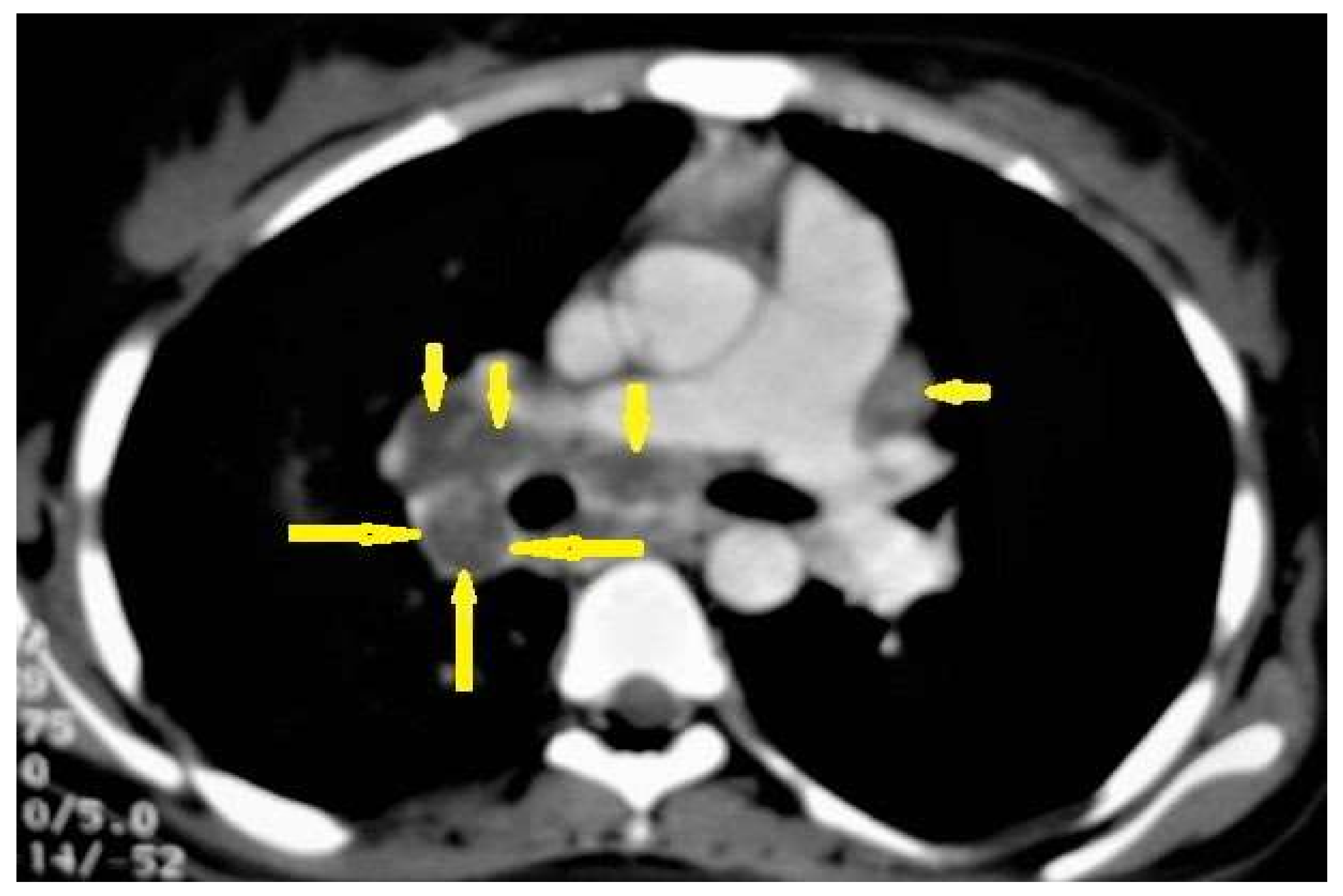
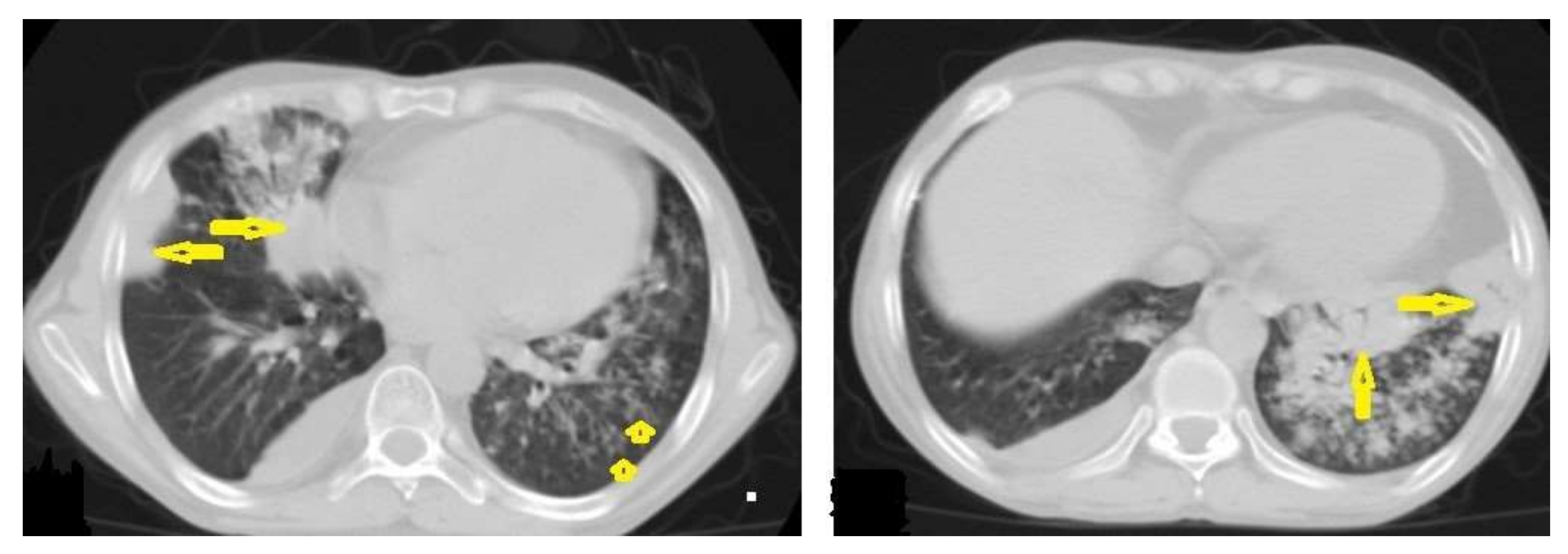
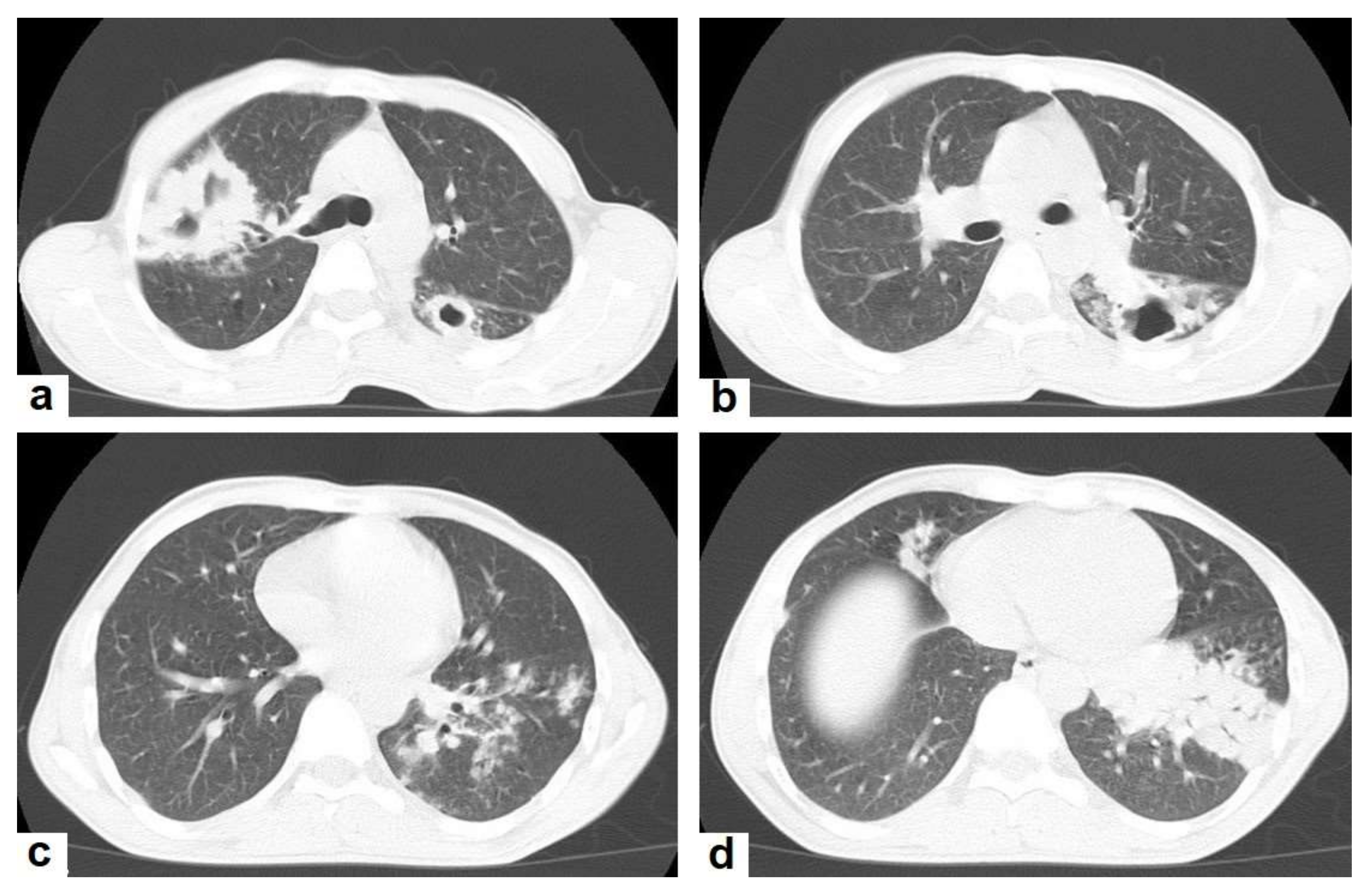
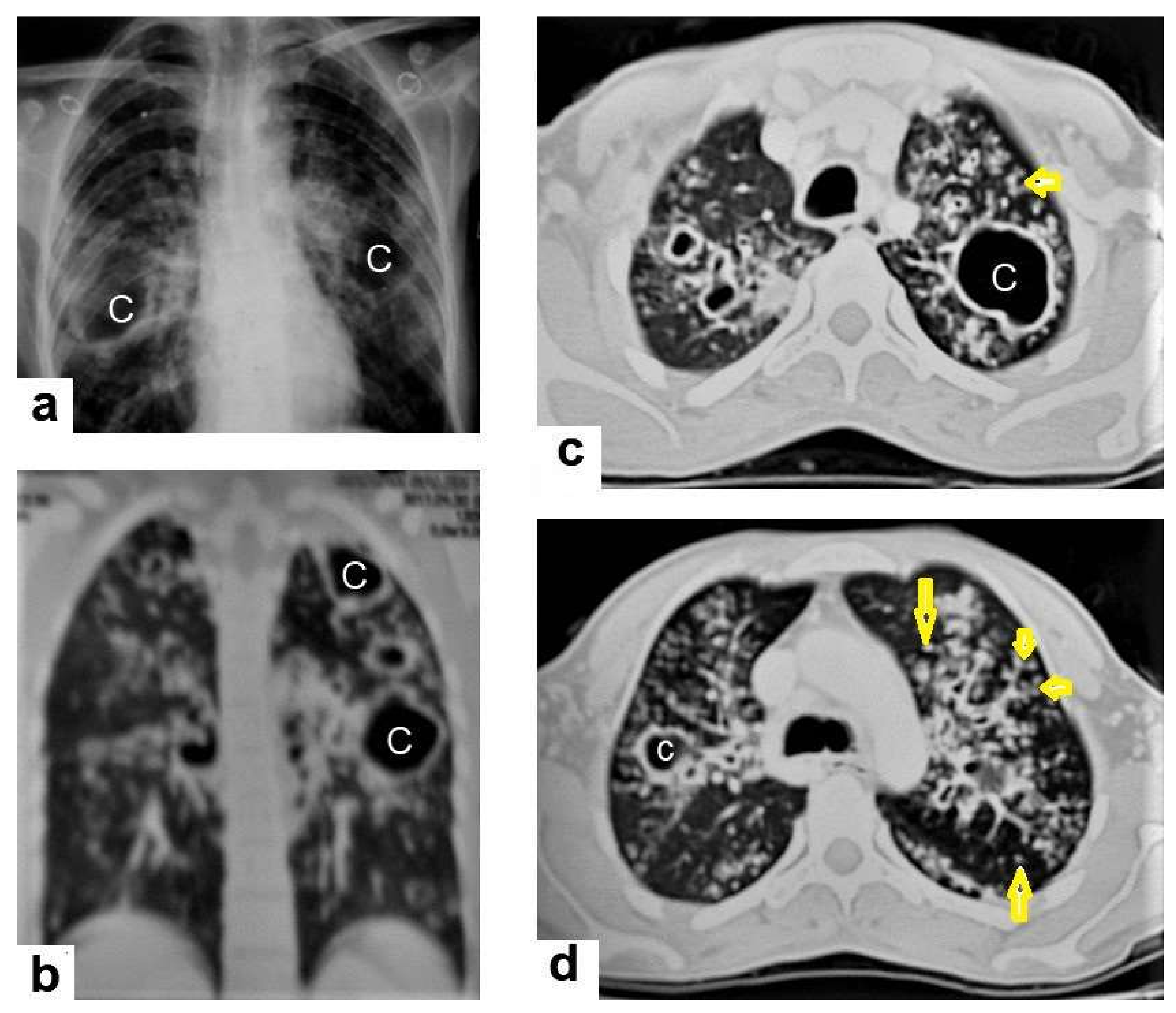
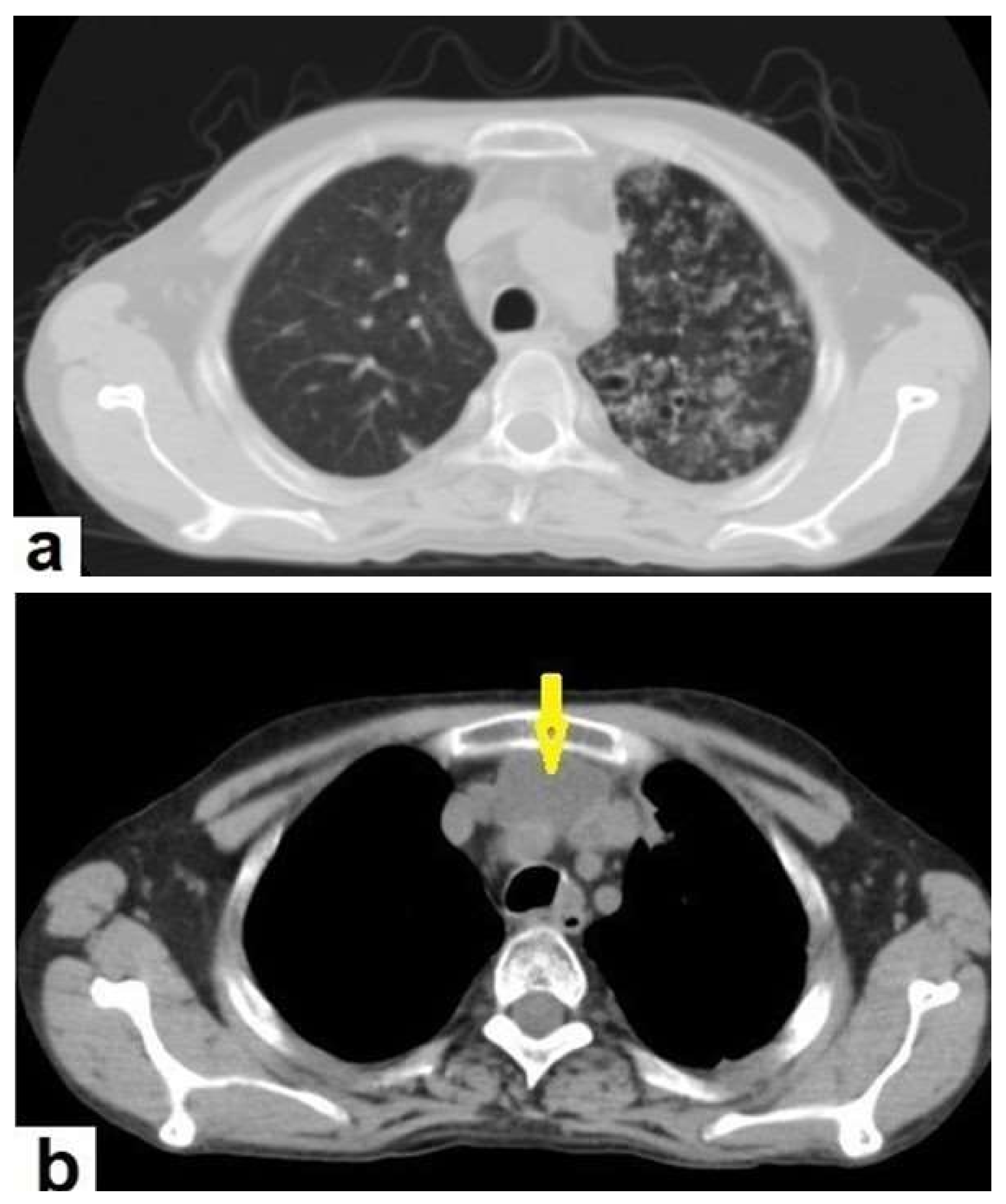
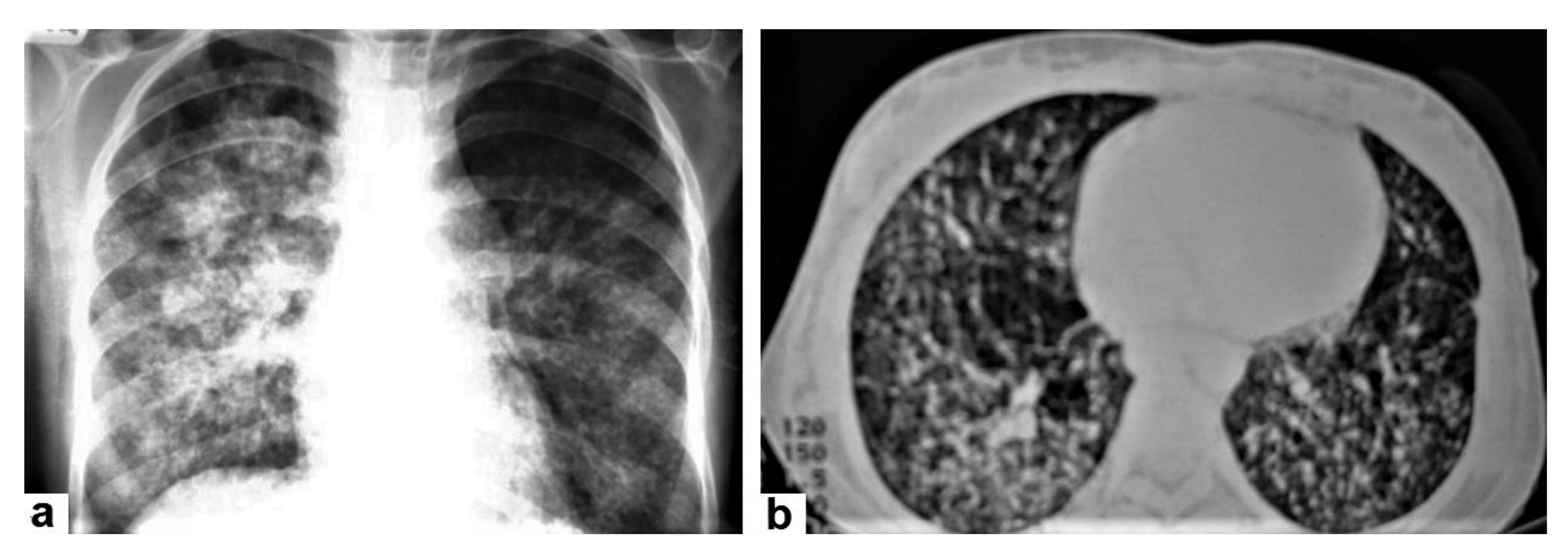
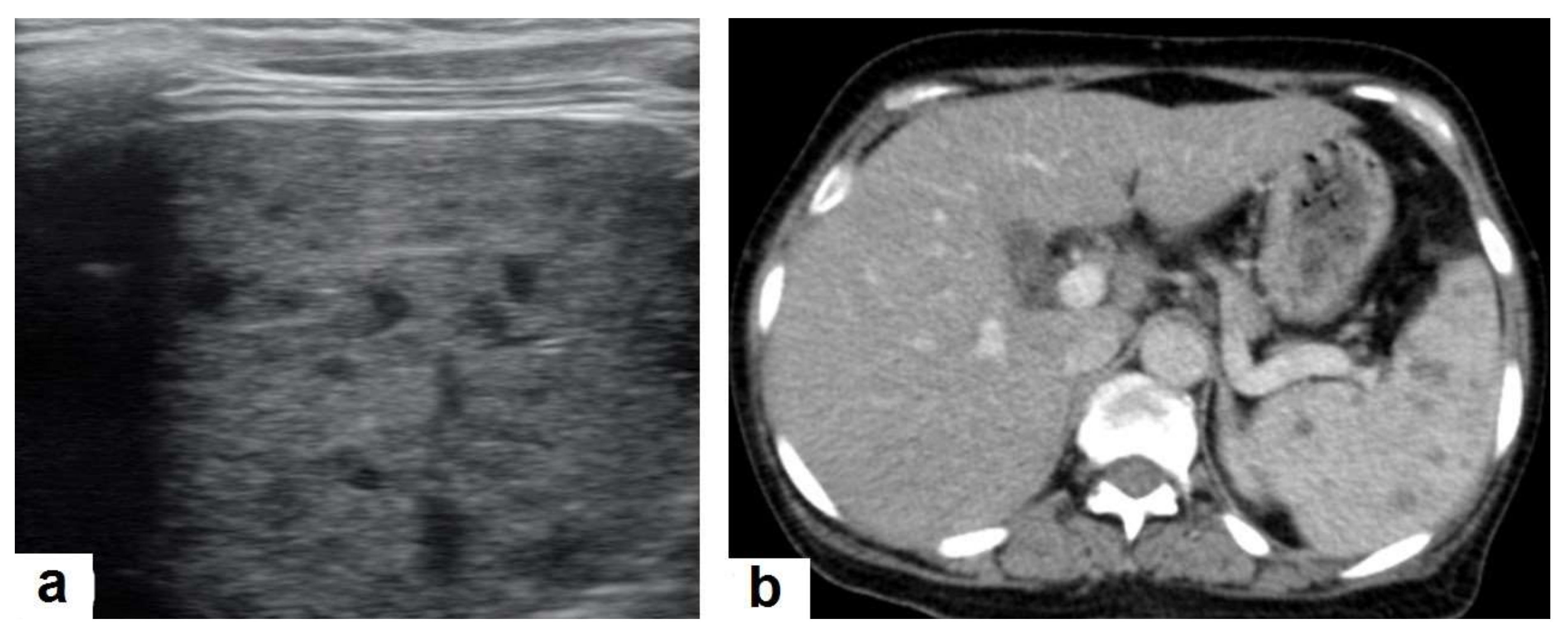
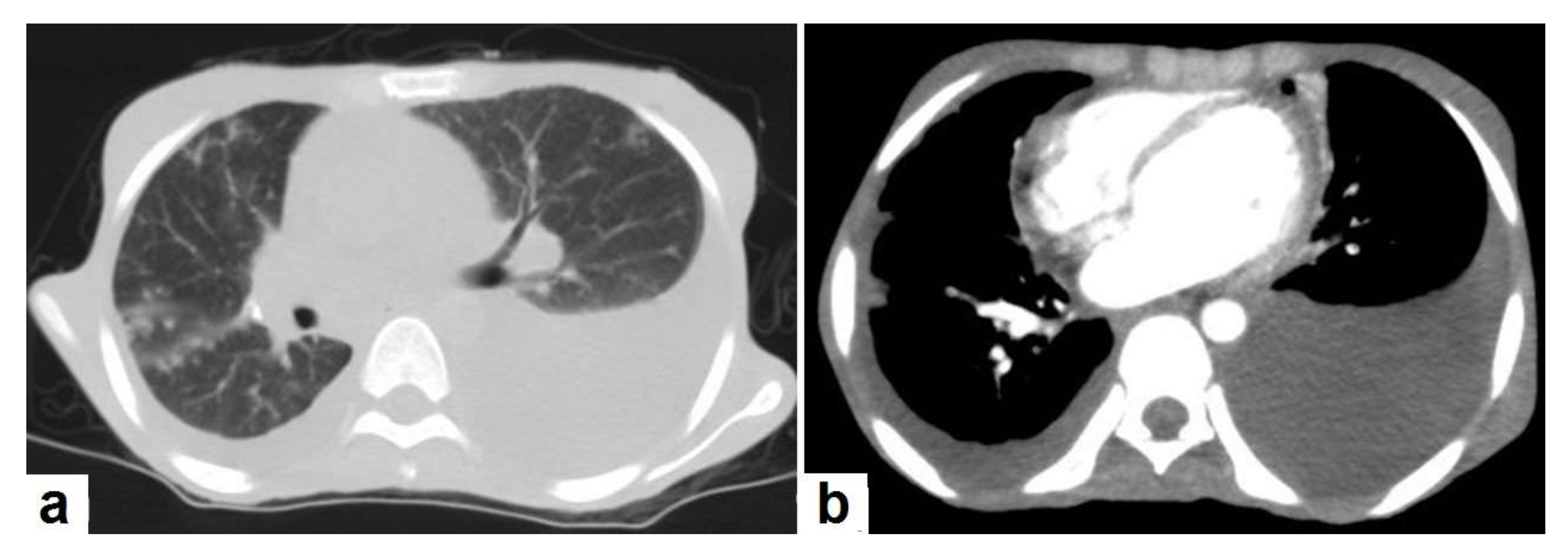
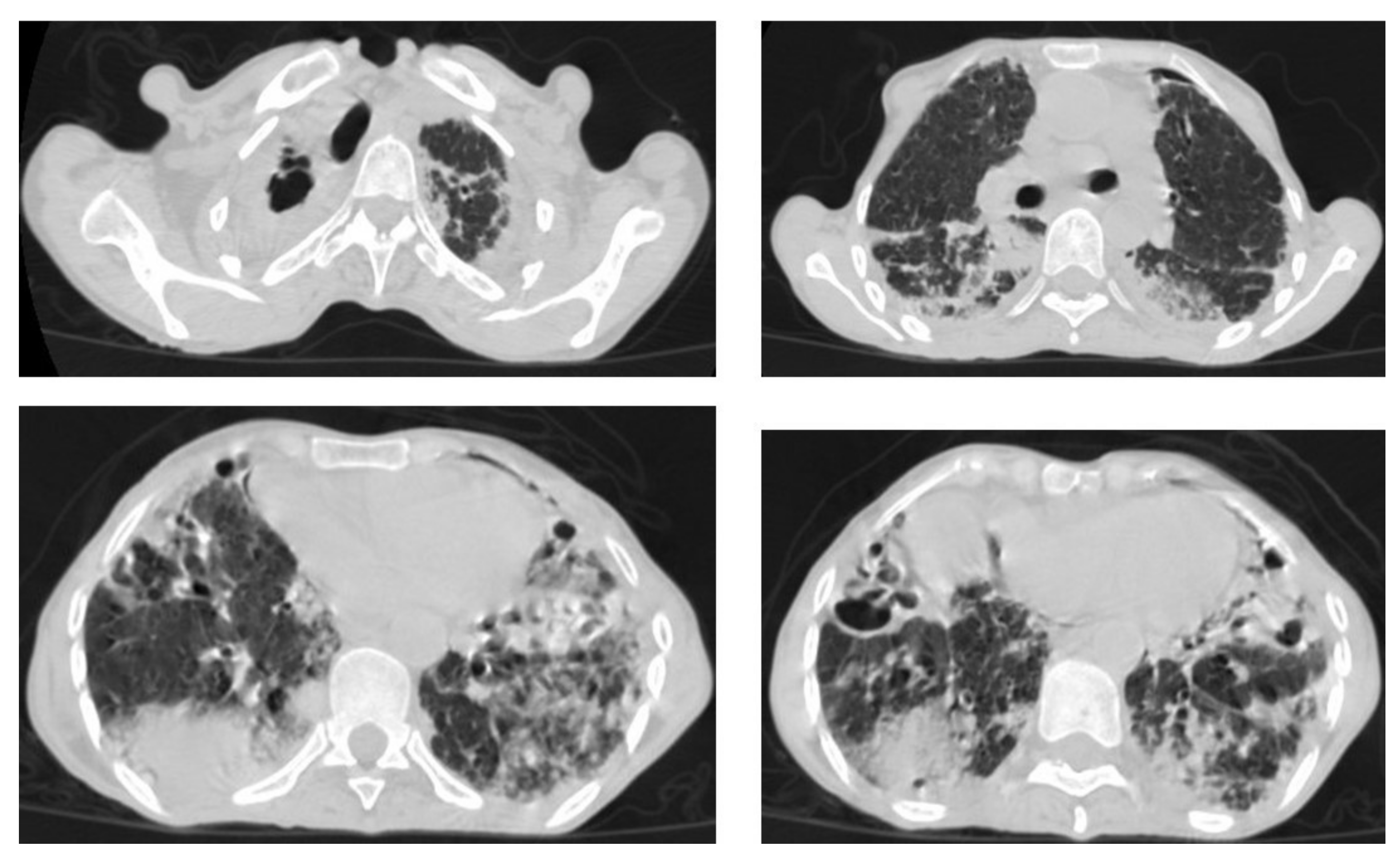
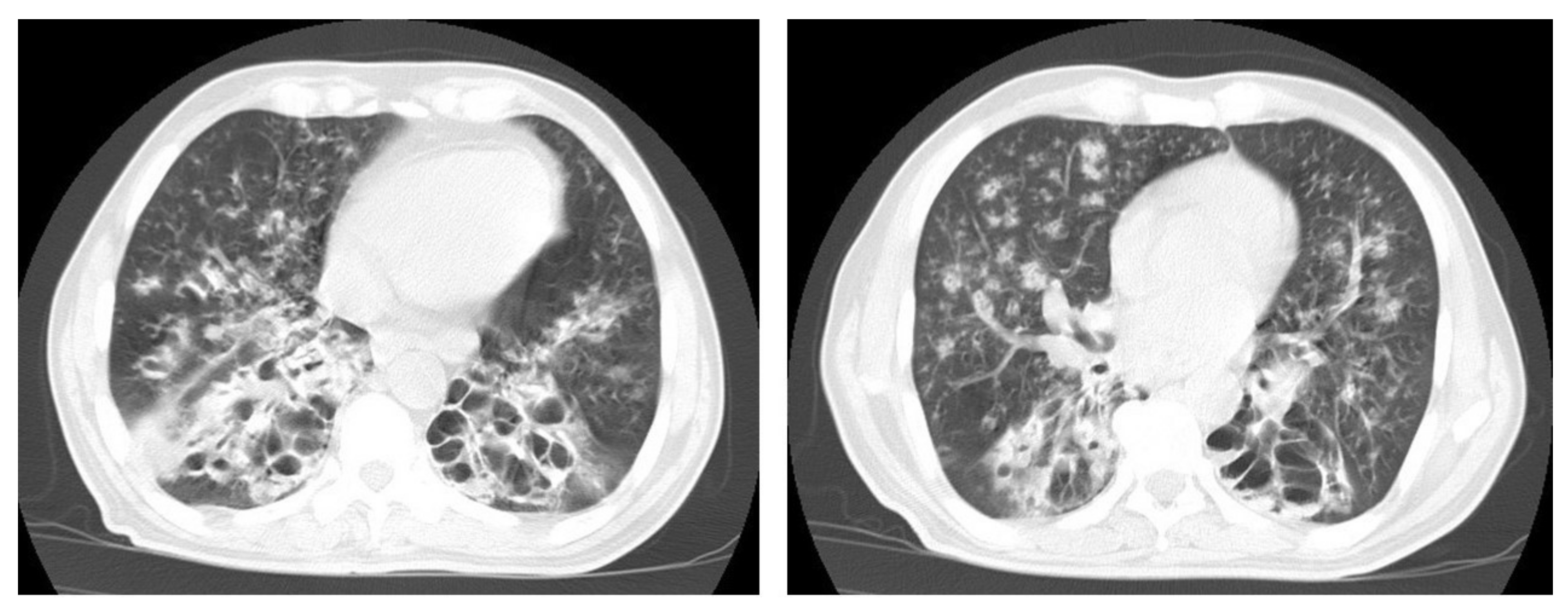

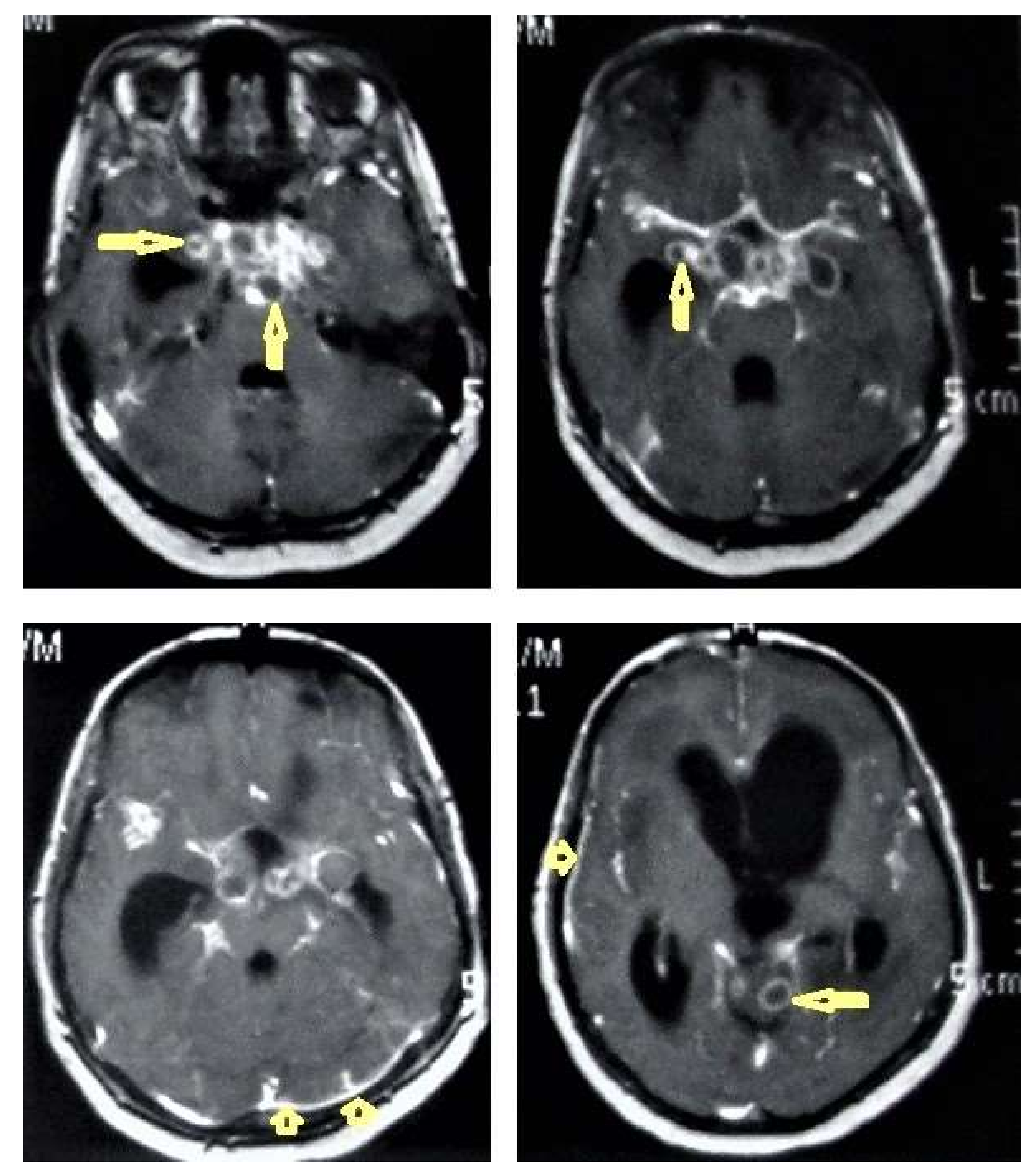
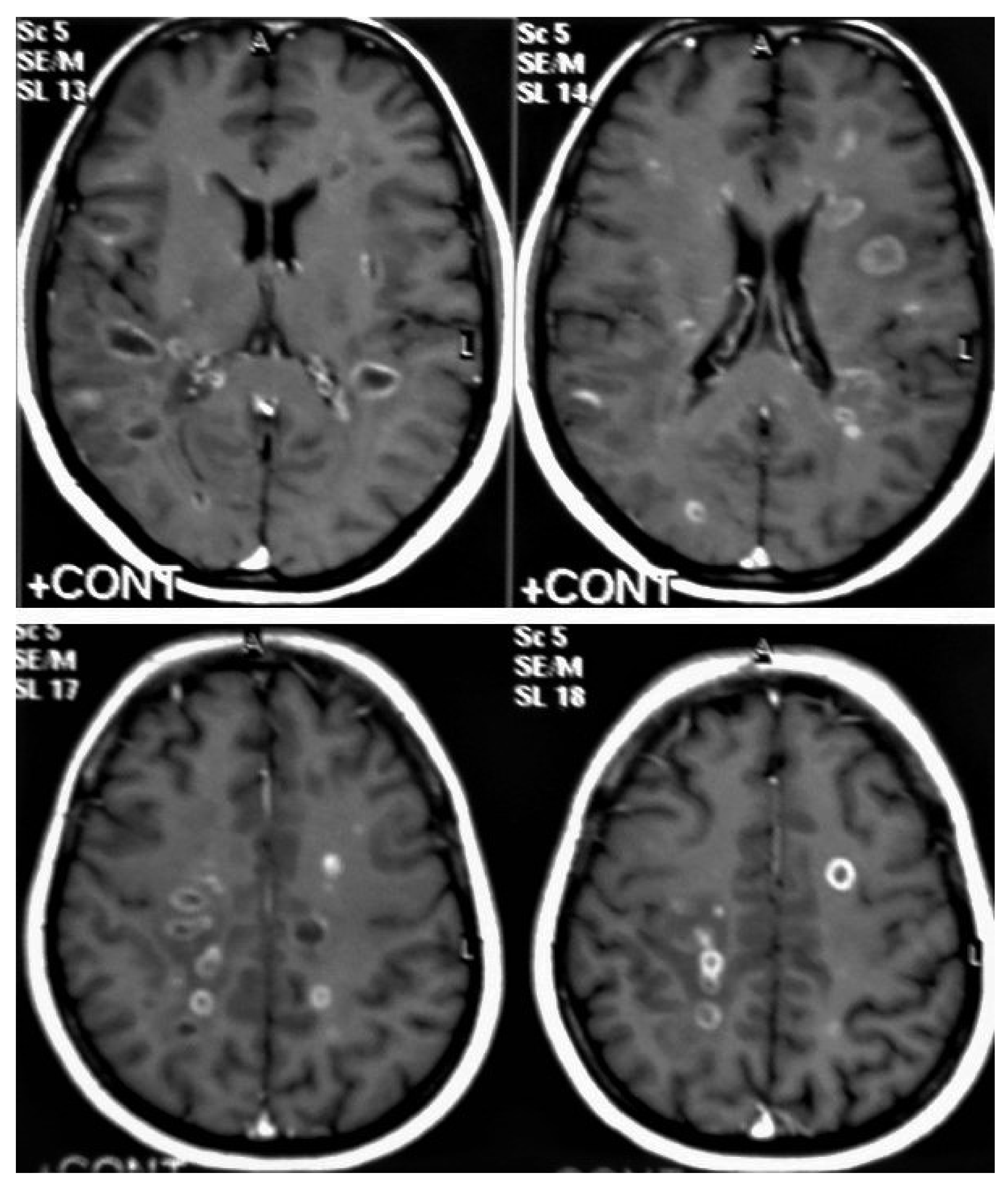
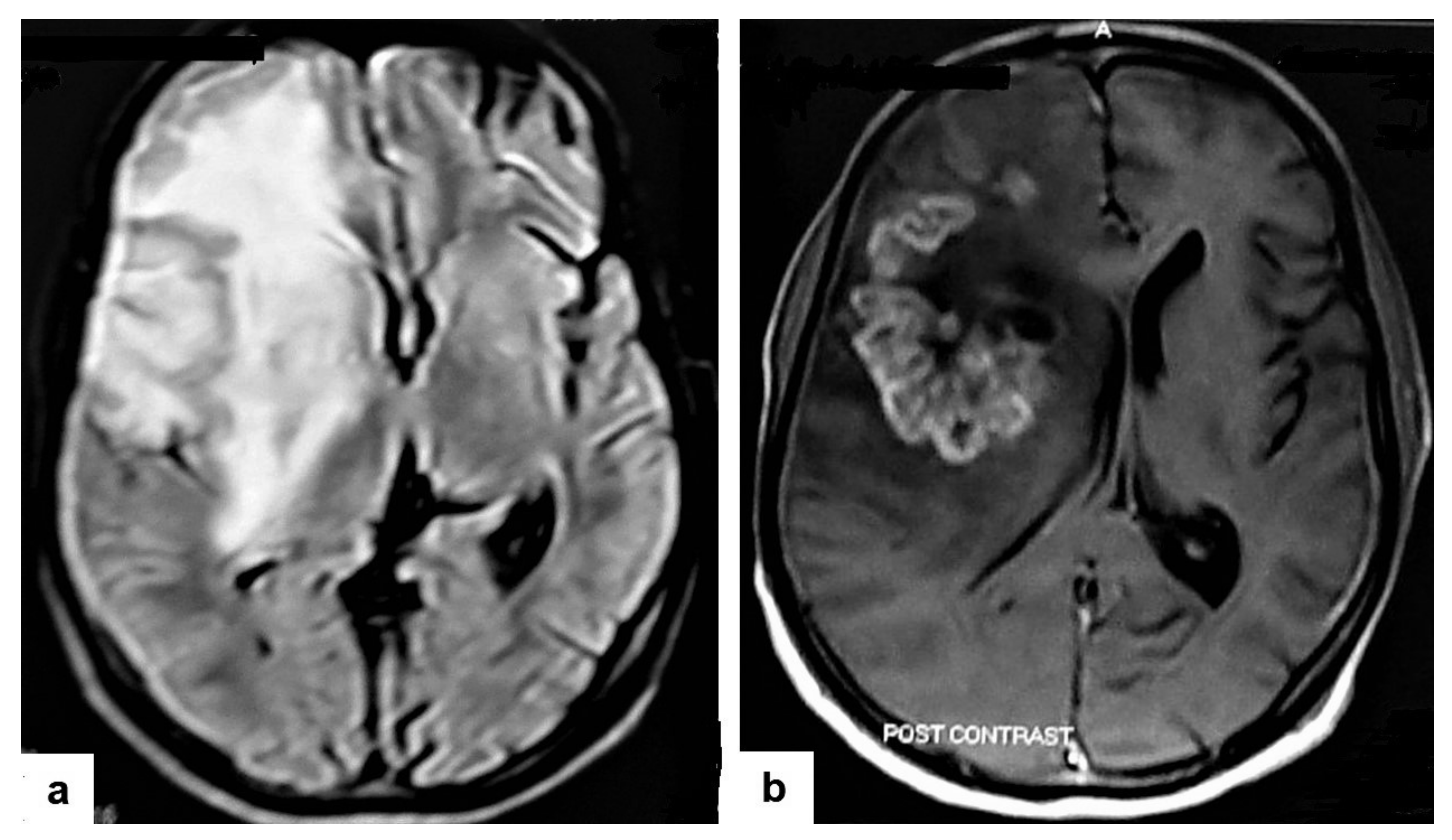
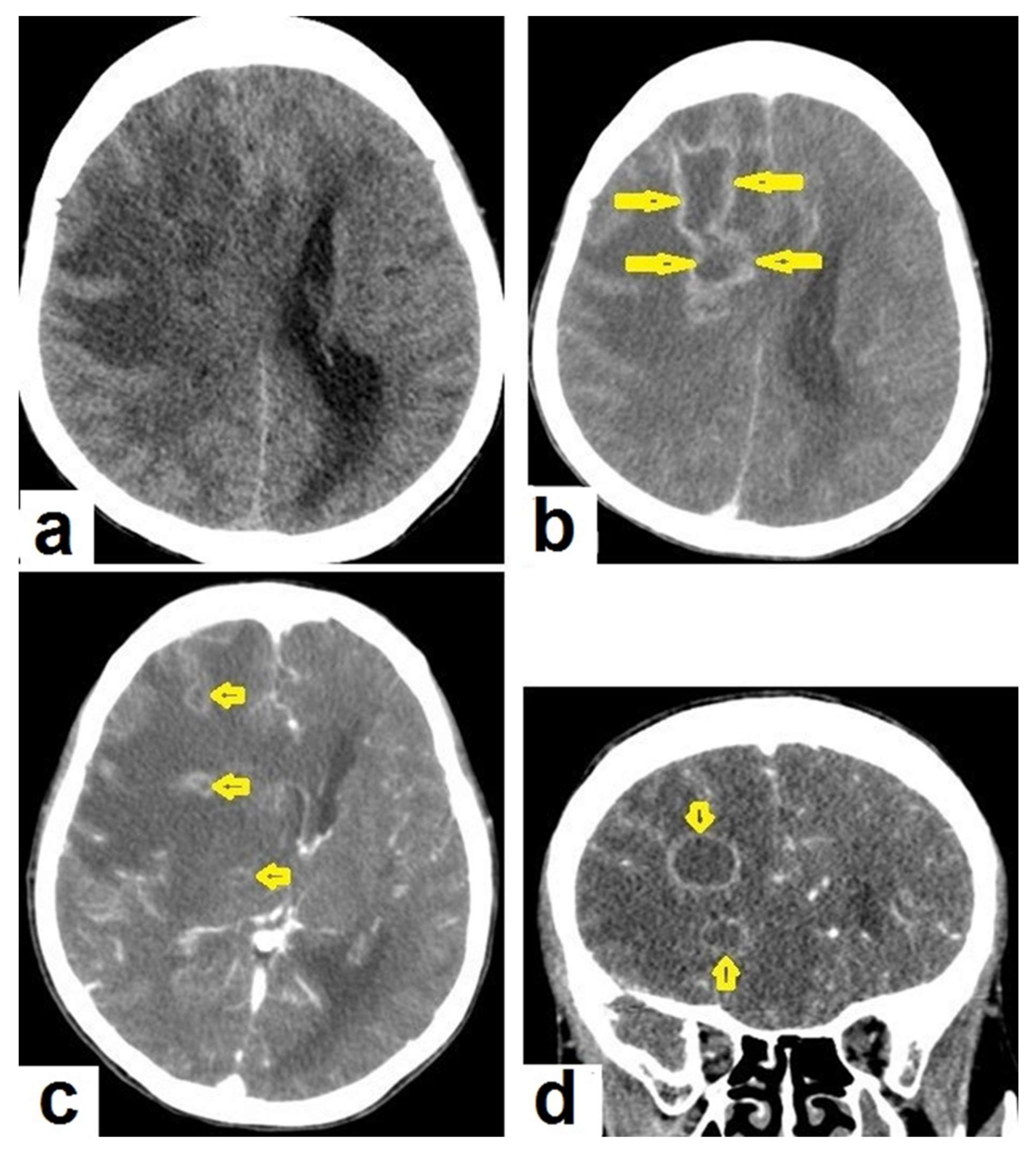
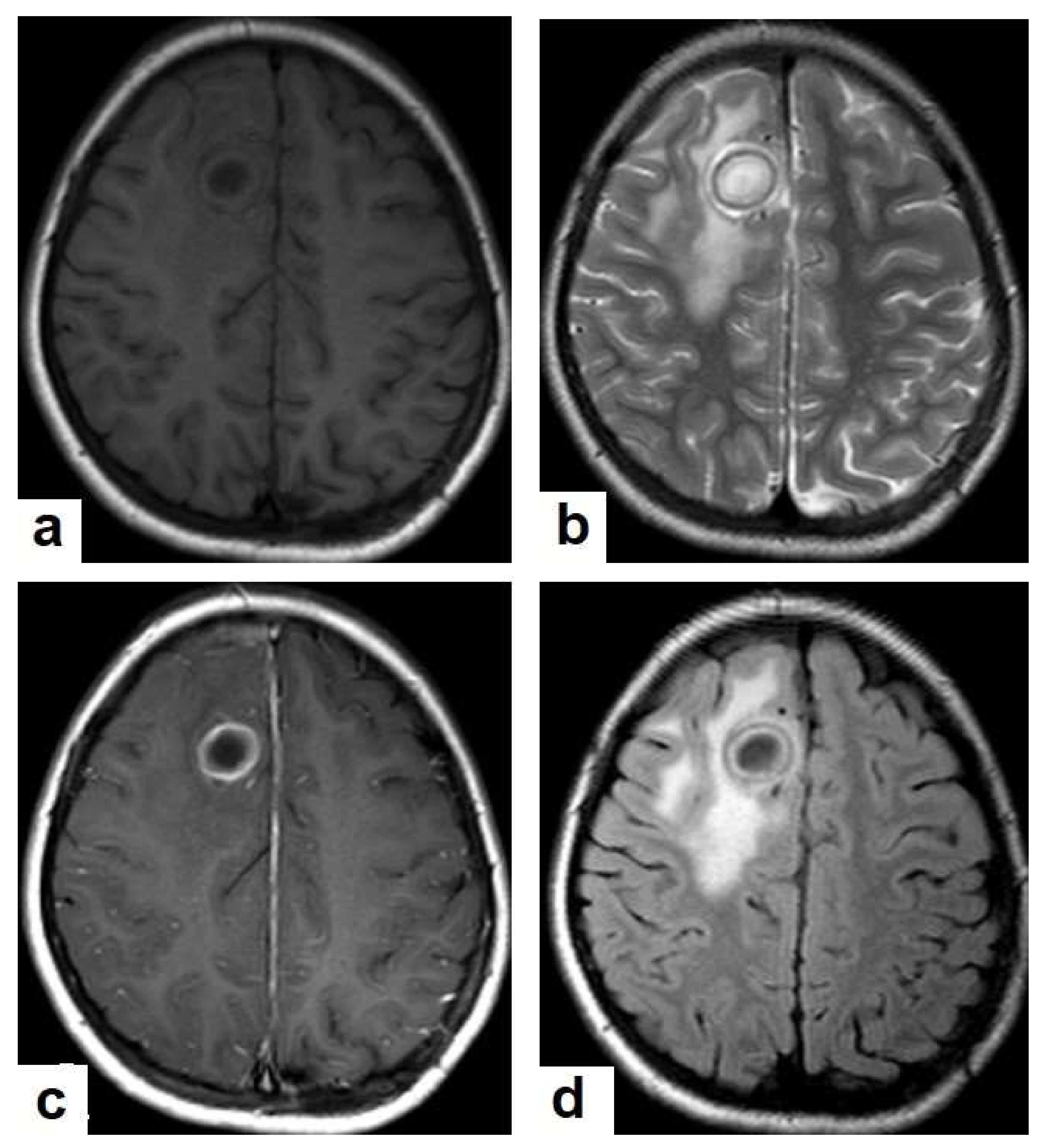
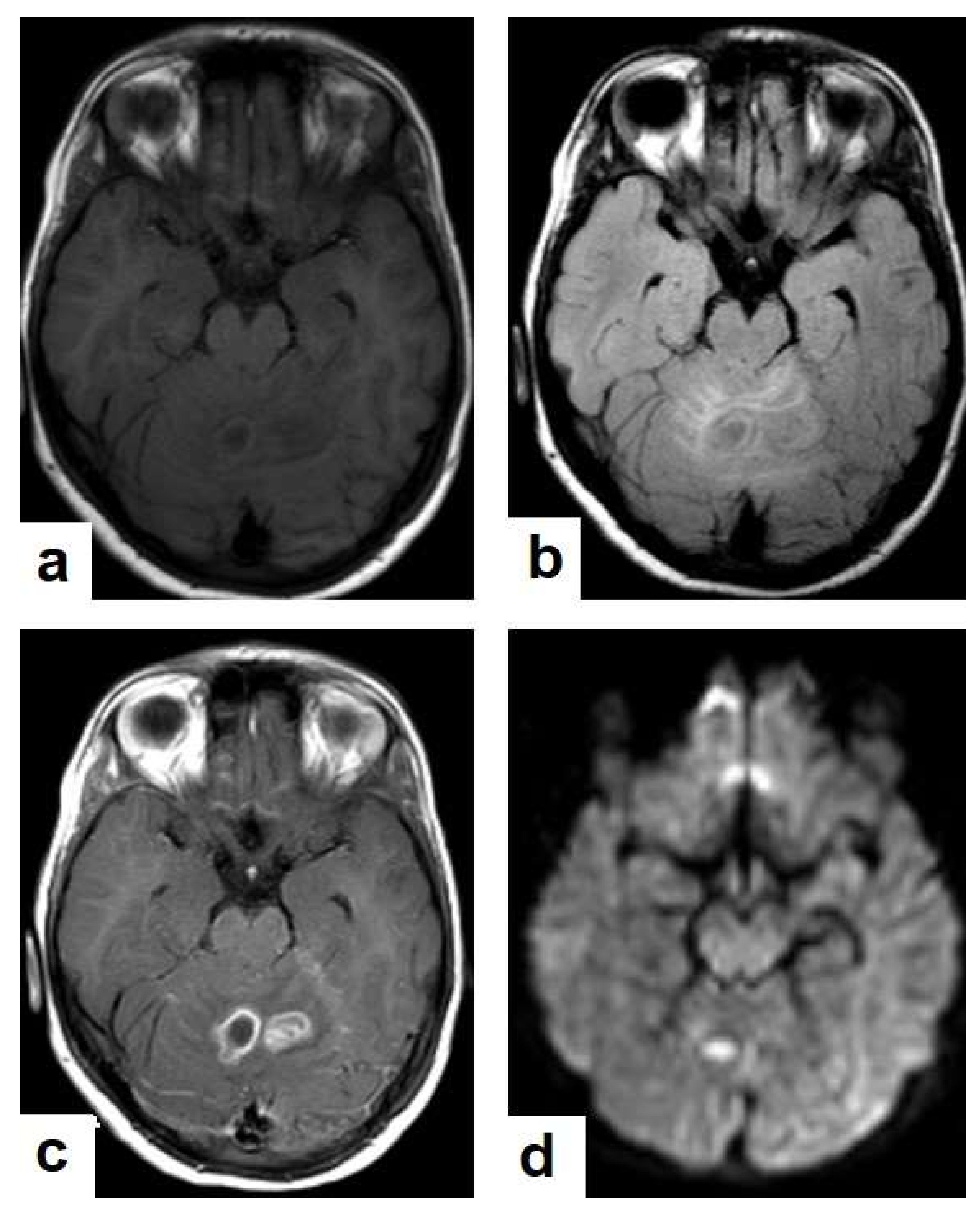
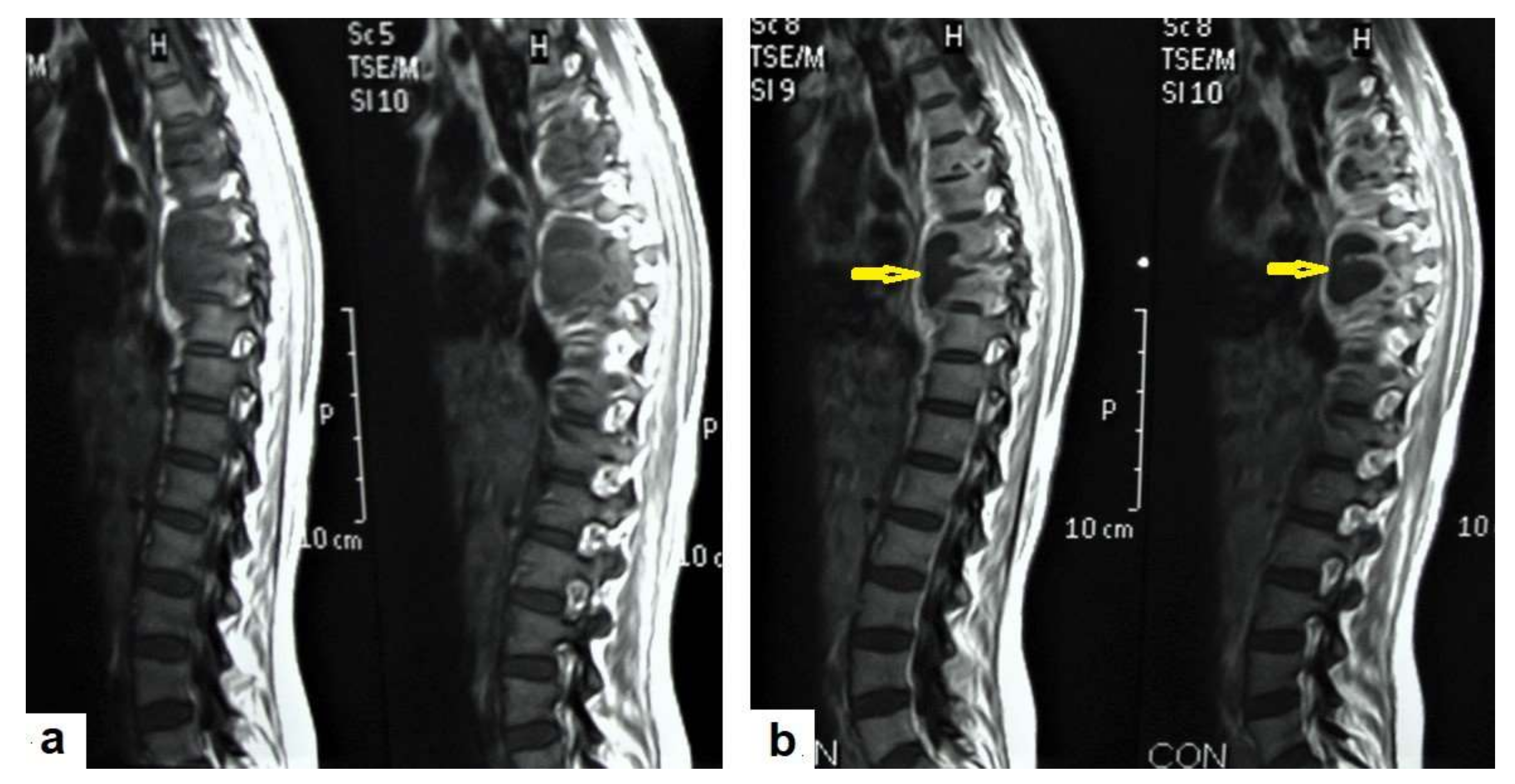
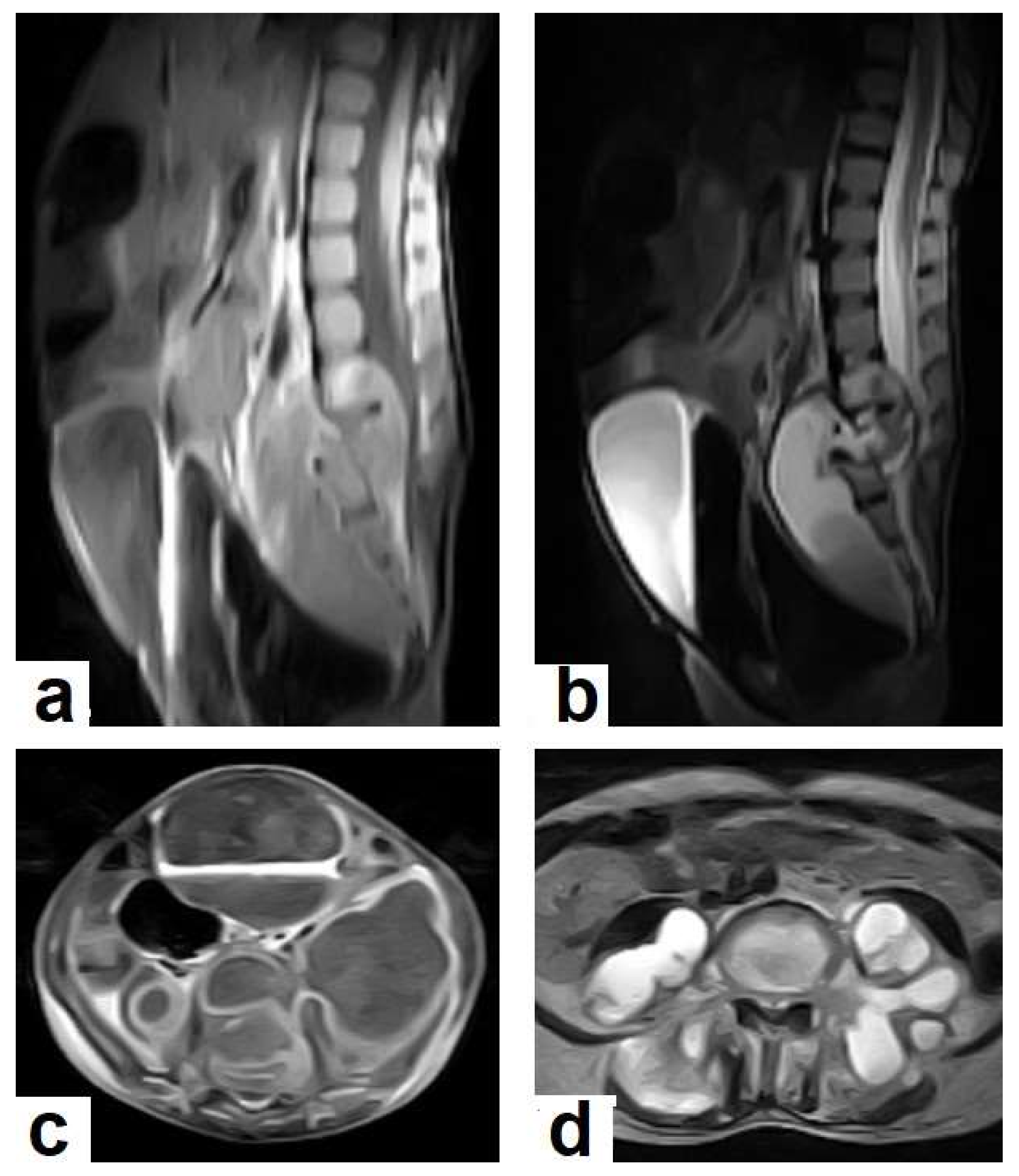
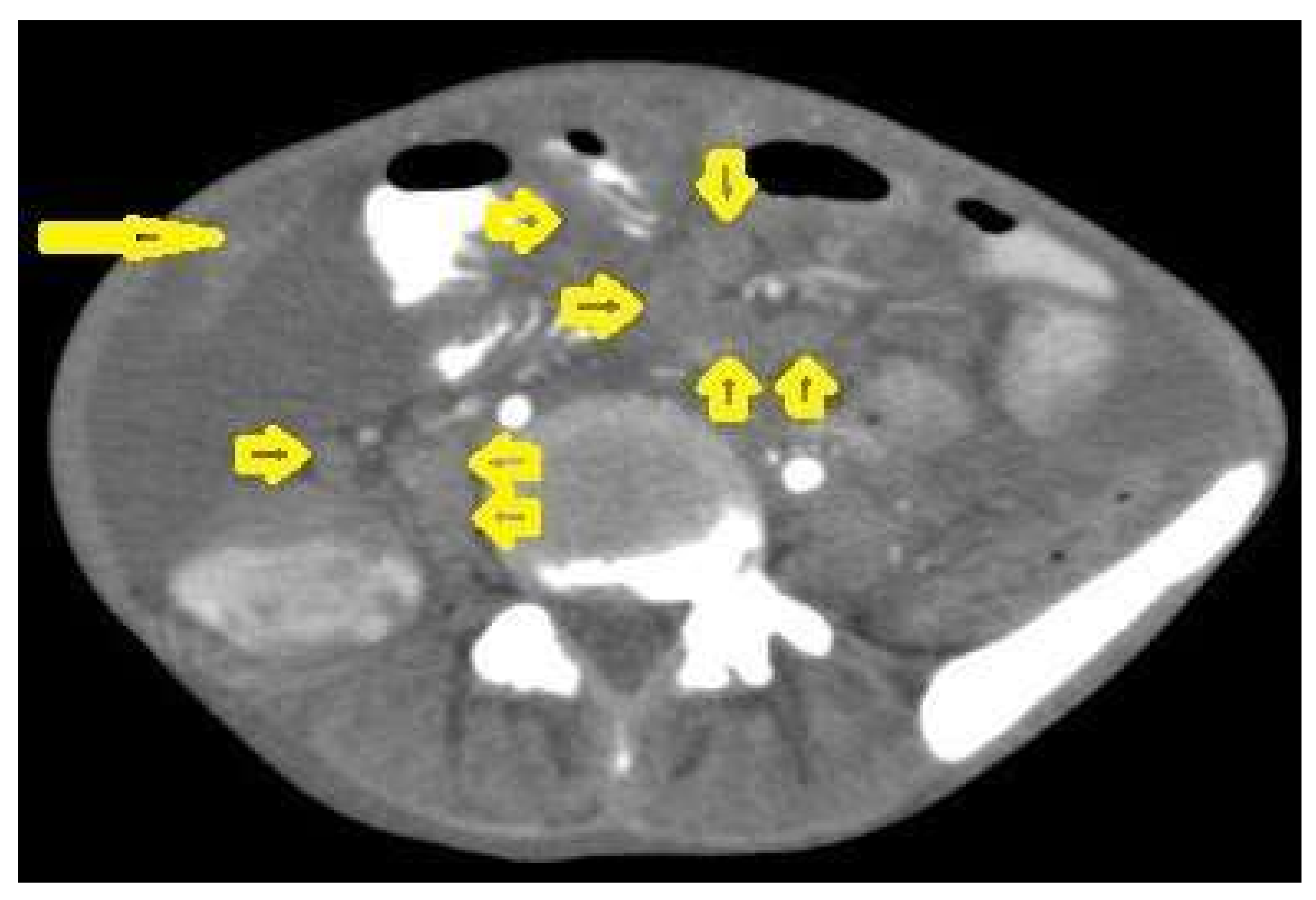
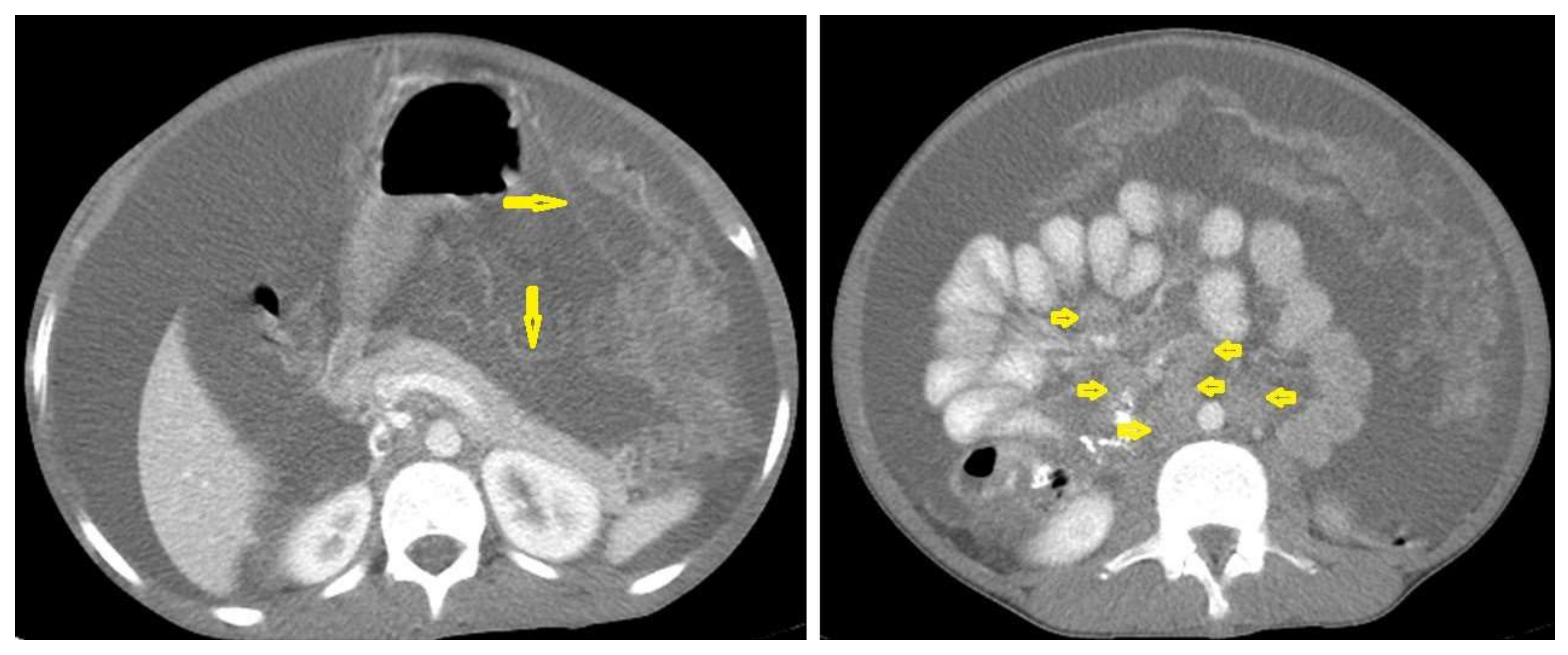
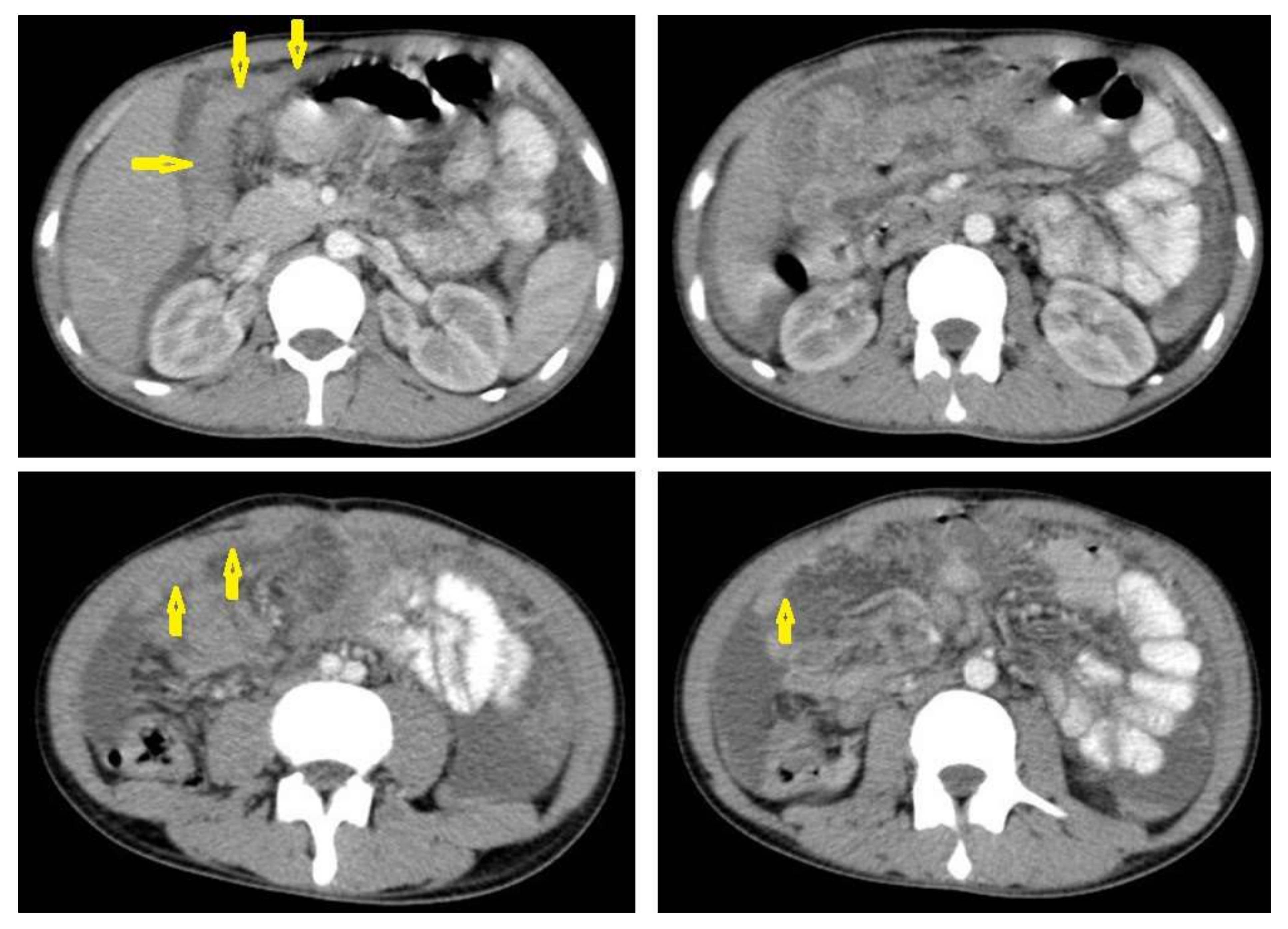
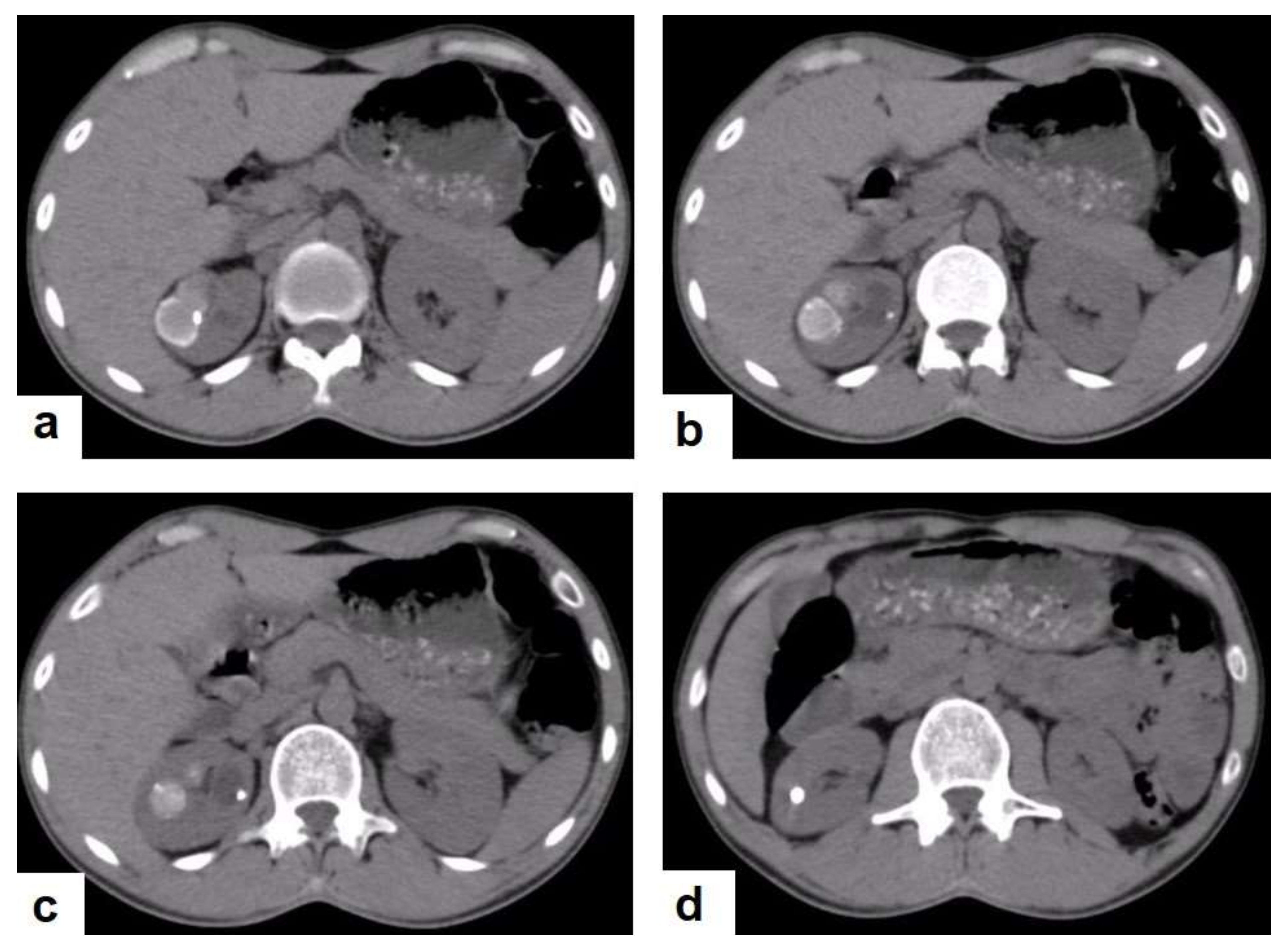
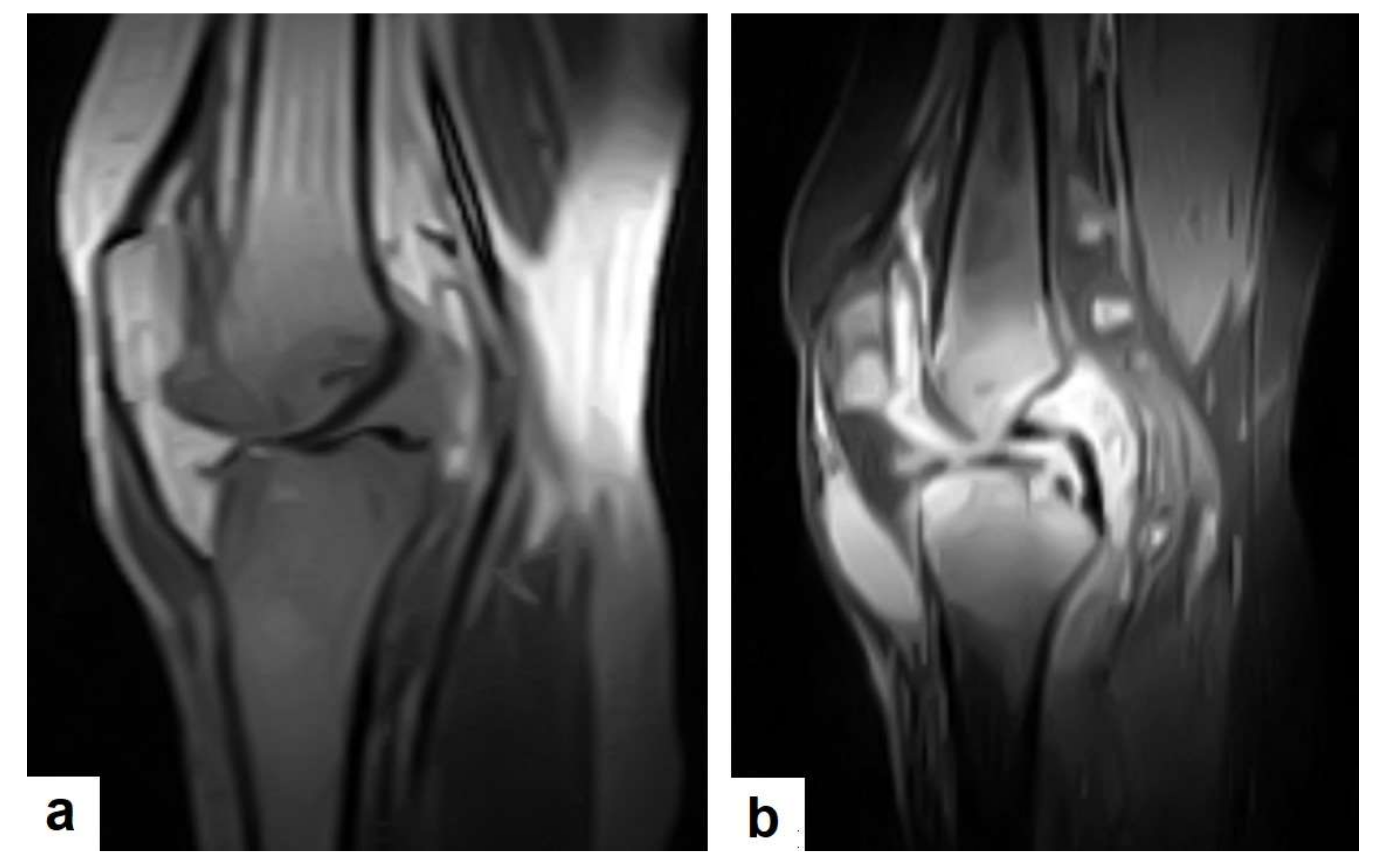
Publisher’s Note: MDPI stays neutral with regard to jurisdictional claims in published maps and institutional affiliations. |
© 2022 by the authors. Licensee MDPI, Basel, Switzerland. This article is an open access article distributed under the terms and conditions of the Creative Commons Attribution (CC BY) license (https://creativecommons.org/licenses/by/4.0/).
Share and Cite
Alshoabi, S.A.; Almas, K.M.; Aldofri, S.A.; Hamid, A.M.; Alhazmi, F.H.; Alsharif, W.M.; Abdulaal, O.M.; Qurashi, A.A.; Aloufi, K.M.; Alsultan, K.D.; et al. The Diagnostic Deceiver: Radiological Pictorial Review of Tuberculosis. Diagnostics 2022, 12, 306. https://doi.org/10.3390/diagnostics12020306
Alshoabi SA, Almas KM, Aldofri SA, Hamid AM, Alhazmi FH, Alsharif WM, Abdulaal OM, Qurashi AA, Aloufi KM, Alsultan KD, et al. The Diagnostic Deceiver: Radiological Pictorial Review of Tuberculosis. Diagnostics. 2022; 12(2):306. https://doi.org/10.3390/diagnostics12020306
Chicago/Turabian StyleAlshoabi, Sultan Abdulwadoud, Khaled M. Almas, Saif A. Aldofri, Abdullgabbar M. Hamid, Fahad H. Alhazmi, Walaa M. Alsharif, Osamah M. Abdulaal, Abdulaziz A. Qurashi, Khalid M. Aloufi, Kamal D. Alsultan, and et al. 2022. "The Diagnostic Deceiver: Radiological Pictorial Review of Tuberculosis" Diagnostics 12, no. 2: 306. https://doi.org/10.3390/diagnostics12020306
APA StyleAlshoabi, S. A., Almas, K. M., Aldofri, S. A., Hamid, A. M., Alhazmi, F. H., Alsharif, W. M., Abdulaal, O. M., Qurashi, A. A., Aloufi, K. M., Alsultan, K. D., Omer, A. M., & Daqqaq, T. S. (2022). The Diagnostic Deceiver: Radiological Pictorial Review of Tuberculosis. Diagnostics, 12(2), 306. https://doi.org/10.3390/diagnostics12020306





